September 1- 7, 2013: Issue 126
First Naval Exercises by New South Wales Colonial Ships – The Wolverene at Broken Bay
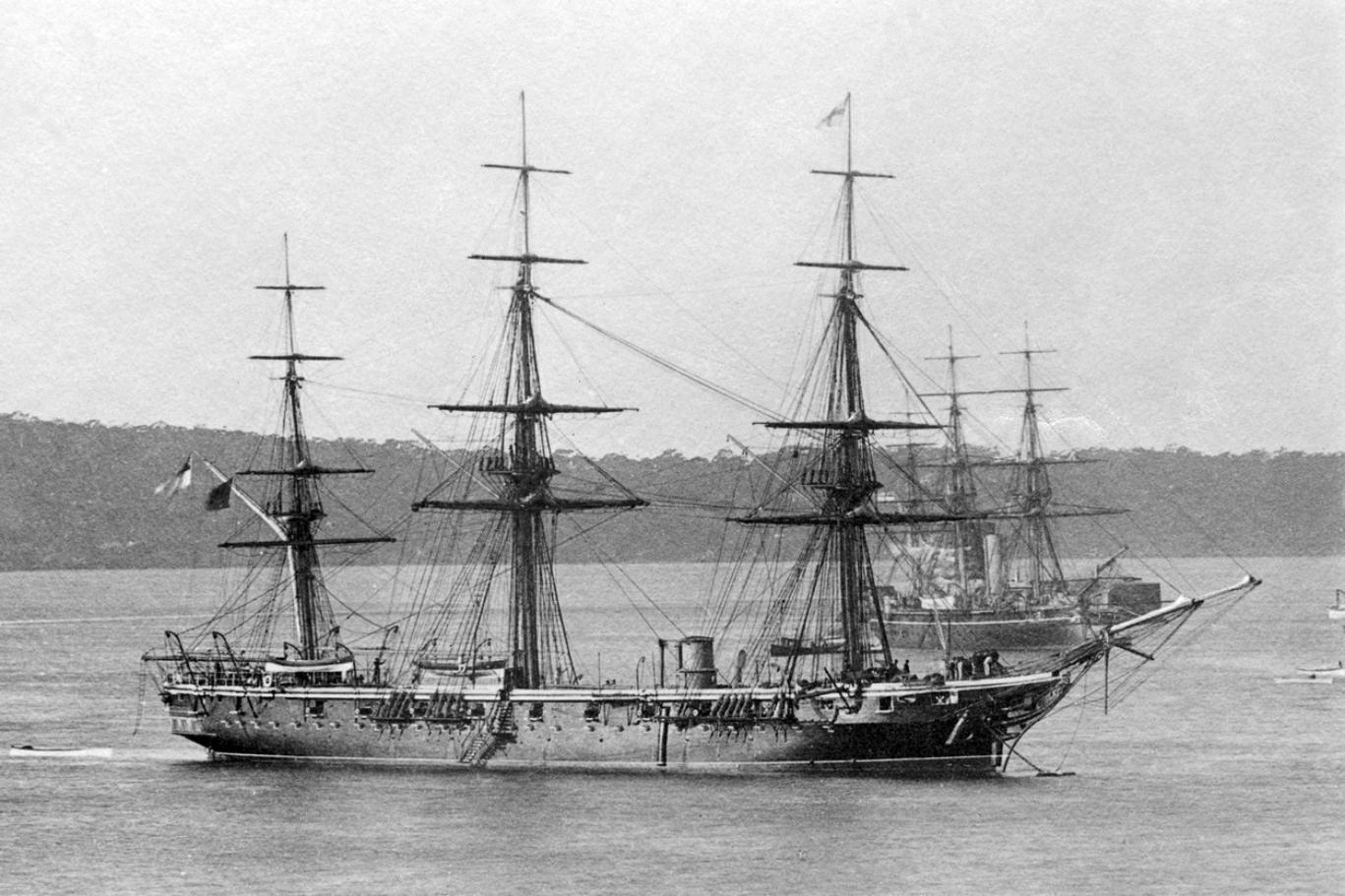
First Naval Exercises by New South Wales Colonial Ships – The Wolverene at Broken Bay
In the lead up to the International Fleet Review in Sydney Harbour, October 3-11 2013, celebrating the entry of our own Australian Navy fleet into Sydney Harbour 100 years ago, we would like to share a few articles on the lead up events to this great day for New South Wales and Australia and what was said about this first Fleet Review. This year’s International Fleet Review, to be held in Sydney from 3 - 11 October 2013, will have a series of events, some similar to those that ran October 3rd to 11th, 1913.
It all began a fair while before then though.
It may not surprise many of you that the first ever Naval Exercises carried out by colonial vessels began from Broken Bay – where else? Broken Bay and Pittwater, a mere row away for some in the early days of the colony of New South Wales, had been identified as a safe and deep sheltering harbour soon after the arrival of the First Fleet, and to be the starting point for any practice session, and so many since, accords to our home waters the recognition of what was, and still is, a maritime community.
When you read the reports below, please bear in mind that the names of these now legendary and long gone vessels later became the names of future Royal Australian Naval vessels; Wolverines with an ‘I’ and succeeding Juno. This too carries forward and communicates inherent Australian Naval history.
In the years that followed the settlement of Australia in 1788 the Royal Navy did not maintain a permanent force in the new colony. The new Port Jackson colony was placed under the protection of the East Indies Station of the British Royal Navy from which vessels were detached occasionally to visit the new colony. From 1821 the Royal Navy maintained a permanent man-of-war in the colony. Over the next 20 years the vessels based on Port Jackson included the sixth rates Alligator, Caroline, Conway, Imogene, and Rattlesnake, and the sloops Hyacinth, Pelorus and Zebra.
.jpg?timestamp=1377865090371) In 1848, an Australian Division of the East Indies Station was established. On 25 March 1859 the British Admiralty established an independent command, the Australia Station, and Captain William Loring of Iris was authorised to hoist a commodore's blue pennant and to assume command as senior officer of Her Majesty's Ships on the Australia Station (Commander-in-Chief, Australia Station), this new command was independent of the commander-in-chief in India.
In 1848, an Australian Division of the East Indies Station was established. On 25 March 1859 the British Admiralty established an independent command, the Australia Station, and Captain William Loring of Iris was authorised to hoist a commodore's blue pennant and to assume command as senior officer of Her Majesty's Ships on the Australia Station (Commander-in-Chief, Australia Station), this new command was independent of the commander-in-chief in India.
This decision was partially in recognition of the fact that a large part of the East Indies Station had been detached to Australian waters, while also reflecting growing concern for the strategic situation in the western Pacific in general, and in Tahiti and New Zealand in particular. Ships serving on the Station were assigned to the Australian Squadron. In 1884 the station was upgraded to a rear admiral's command.
Photo to left: AWM: "SYDNEY, NSW. C.1880. SHIPS OF THE ROYAL NAVY'S SQUADRON ON THE AUSTRALIA STATION MOORED IN FARM COVE. (LEFT TO RIGHT) SCREW SLOOP HMS EGERIA, SCREW CORVETTE HMS RAPID, SCREW SLOOP HMS ALERT, SCREW CORVETTES HMS OPAL AND CALLIOPE. THE PHOTOGRAPH WAS TAKEN FROM FORT DENISON".
At its establishment, the Australia Station encompassed Australia and New Zealand, with its eastern boundary including Samoa and Tonga, its western edge in the Indian Ocean, south of India and its southern edge defined by the Antarctic Circle. The boundaries were modified in 1864, 1872, 1893, and 1908. At its largest, the Australia Station reached from the Equator to the Antarctic in its greatest north-south axis, and covered one quarter of the Southern Hemisphere in its extreme east-west dimension, including Papua New Guinea, New Zealand, Melanesia and Polynesia.
Victoria, as early as 1870, had her own fleet, but Sydney, and New South Wales, as the main base for the Royal Navy, feared no invaders until the outbreak of the Crimean War. By 1854 the Government was calling for tenders for a gunboat to defend Sydney. The vessel built was HMCS Spitfire (launched 4 April 1855; a 65 ton sail gunboat- hull was sheathed with 22 ounce copper), the first naval vessel completed solely by an Australian colonial government. Please note that where you see 'HMCS' in this particular era it defines- Her Majesty's Colonial Ship (HMCS).
In 1913, the Australian Squadron was disbanded, and responsibility for the Station was handed over to the new Royal Australian Navy, at which time it covered Australia and its island dependencies to the north and east and also at which time Sydney saw her Royal Australian Navy arrive on the harbour, 100 years ago this October!
By 1860 the New South Wales government began talking about forming some in house defenders and in May 1863 the Naval Brigade, of only 120 men to begin with, was established. The Naval Brigade headquarters was established at Fort Macquarie, where the Sydney Opera House today stands. By 1864 it consisted of five companies, four in Sydney and one in Newcastle, with an overall strength of 200 men.
.jpg?timestamp=1377864821882) There were still very little ‘home’ vessels though until late in the 1870’s when the New South Wales Government paid for two second class torpedo boats that were constructed in Sydney, the Avernus (right - on Sydney Harbour) and Acheron. In 1880 the New South Wales Naval Artillery Volunteers was formed. The Naval Brigade were equivalent to the Naval Reserve as it is known today. The Naval Artillery Volunteers, or more usually as the NAVs, were mainly employed manning the fixed defences and have been likened by the Navy History Organisation as akin to the Royal Marine Artillery than the navy proper.
There were still very little ‘home’ vessels though until late in the 1870’s when the New South Wales Government paid for two second class torpedo boats that were constructed in Sydney, the Avernus (right - on Sydney Harbour) and Acheron. In 1880 the New South Wales Naval Artillery Volunteers was formed. The Naval Brigade were equivalent to the Naval Reserve as it is known today. The Naval Artillery Volunteers, or more usually as the NAVs, were mainly employed manning the fixed defences and have been likened by the Navy History Organisation as akin to the Royal Marine Artillery than the navy proper.
To support the training of these men the British Government gave the colony a Christmas Present in 1881. She was presented to the Colony of New South Wales as a training ship for the New South Wales Naval Brigade and New South Wales Naval Artillery Volunteers — challenging "enemy" ships at Sydney heads and "attacking" coastal and harbour fortifications.
WOLVERENE. LONDON, December 19.-'The British Government has agreed to make a present to the New South Wales Government of H.M.S. Wolverene, fully armed. THE WOLVERENE. (1881, December 24). Australian Town and Country Journal (NSW : 1870 - 1907), p. 12. Retrieved from http://nla.gov.au/nla.news-article70963673
.jpg?timestamp=1377866235920) The Wolverene. H.M.C.S. Wolverene has gone to an anchorage off Cockatoo in order to be in readiness, should any emergency occur, in respect to the training ship Vernon (right). The Wolverene. (1890, February 28). Evening News (Sydney, NSW : 1869 - 1931), p. 5. Retrieved from http://nla.gov.au/nla.news-article108797094
The Wolverene. H.M.C.S. Wolverene has gone to an anchorage off Cockatoo in order to be in readiness, should any emergency occur, in respect to the training ship Vernon (right). The Wolverene. (1890, February 28). Evening News (Sydney, NSW : 1869 - 1931), p. 5. Retrieved from http://nla.gov.au/nla.news-article108797094
The ship was decommissioned in 1892, sold to a private firm (Peter Ellison, Sydney) for £2,200 in August 1893 and with the engines removed was used as a hulk.
H.M.C.S. Wolverene. The Government has decided that H.M.C.S. Wolverene shall be dismantled and sold out of the service as useless for defence purposes. The old ship will be sold by tender, and the Cabinet will at an early date decide what arrangements shall be made for the training of the Naval Brigade, which for some years has had the Wolverene for instruction purposes. H.M.C.S. Wolverene. (1892, November 28). Evening News(Sydney, NSW : 1869 - 1931), p. 6. Retrieved from http://nla.gov.au/nla.news-article113313818
After refit and conversion to a barque, she commenced service as a merchant vessel. On a voyage from Sydney to Liverpool, England she sprung leaks and returned to Auckland for repairs, however upon docking she was found to be unfit. She was sold to G. Niccol, Auckland, for £1,000. She was partially scrapped and her hull was burnt.
What is related below is the first Naval Exercise to test these two colonial naval services;
ON BOARD THE WOLVERENE.
For the first time in the history of the colony a colonial naval force took part in the Easter manouvres, and their doing so contributed largely to the interest of the proceedings. When the Naval Volunteer Artillery were formed people were found to sneer at the idea, as they had done in the case of the land volunteers, of their becoming efficient, but the sham fight yesterday and the drills which preceded it have effectually proved that our men are able to play their part by sea and by land as defenders of hearths and homes. The plan of naval operations was that a squadron, composed of the Wolverene, Ajax, Captain Cook, Juno, and Neptune, should rendezvous in Broken Bay at 11 a m yesterday, and at noon proceed to sea, where they would engage with an imaginary enemy in the offing, and, after a sharp fight, retreat slowly to Port Jackson, under shelter of the batteries, and that the combined efforts of the military and naval forces and of the torpedo corps would completely vanquish the attacking cruisers. The hopper barges Juno and Neptune were manned entirely by the Naval Volunteer Artillery, the others by the Naval Brigade. The full strength of the brigade is 327 petty officers and men and it is a gratifying evidence of their interest in their work that 308 of them reported themselves for duty, 208 being allotted to the Wolverene, 60 (being the Newcastle contingent) to the Ajax, and 50 to the Captain Cook. The others on the corvette were Commander Lindeman, R N , in command of brigade, Lieutenants Deloitte, Jackson, and Partridge, R N ; sub-Lieutenants Gilfillan, Oatley, Milson, and Broomfield, Midshipmen Jacobs, F.W. Hixson, H Hixson, S. Day, and W. Day, and Cadets Street, Wright, M'Farlane, Traier, Lamb, and Harley Hixson, Dr Evans, staff surgeon , Dr. Knaggs, surgeon, and the gunnery instructor, Mr Rickwood.
_at_Lady_Macquaries_Point.jpg?timestamp=1377866985861)
HMS Wolverene 1863, at Lady Macquarie's Point. Henry King Photo, courtesy Powerhouse Museum.
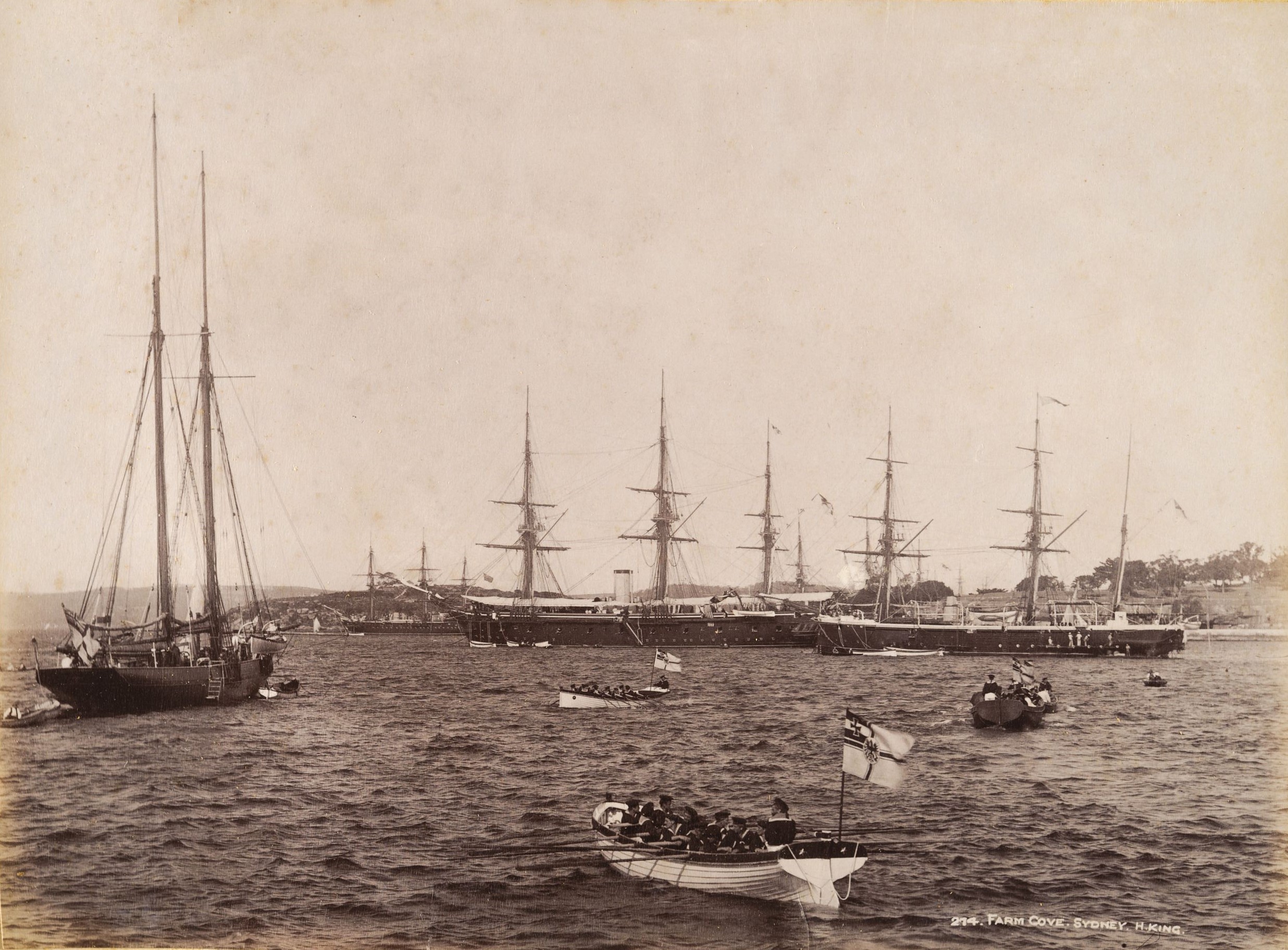
HMS Wolverene and Dart in Farm Cove circa 1879-1880. Item 392226, from part of the Royal Australian Historical Society (RAHS) collection which was donated to the Powerhouse Museum. Photograph in album, entitled 'Farm Cove, Sydney', depicts ships of the Royal Navy's Australia Station including HMS Wolverine, albumen / paper, photographer Henry King, Sydney,
The Ajax was commanded by Captain Cross, under whom were Lieutenant Gardiner, Midshipman Cross, Cadet Hickson, Dr. Baker, and Gunnery-instructor Dagwell. On the Captain Cook the officers were Lieutenant Lewington (in command), Sub-lieutenant Cohen, Midshipman Church, and Cadet Dawson, Lieutenant Commander R. N. Arnold was m charge of the Juno, and Lieutenant Les was in command of the Neptune, and each vessel was fitted up and armed in the manner described in the Herald several days ago. The Wolverene carried 14 guns, seven on each side a Gatling gun in the main-top, and two stern chasers, and the Ajax and the Captain Cook each carried two broadside guns and one stern-chaser. The Naval Brigade had had two drills in harbour on board the Wolverene, but it was not until Saturday afternoon last that they put to sea in her. At 3 pm the main contingent mustered at the horse ferry, Fort Macquarie, and, after waiting half an hour for stragglers, the tender conveyed the brigade to the Wolverene, which, was lying at her buoy in Farm Cove, with steam up ready for a start. While the men and their kits were being got on board a few additional members of the Brigade came hurrying up in a small boat and were only just in time to join their comrades, for shortly after 4 o’clock the Wolverene slipped her moorings and put out to sea, steering southward.
The brigade were then mustered, and a very fine body of men they looked, many of them presenting the unmistakable stamp of the man-of-war's man, and all seeming to know their drill well. Some are veterans, and will soon have to be superannuated, but there is plenty of good young vigour and courage to take the place of those who in the course of time must cease to be available The Government have given orders to double the strength, of the brigade, and eligible recruits are flocking in in such numbers that 50 splendid men were taken on a few nights ago, leaving 70 applicants to be Inspected tomorrow night at Fort Macquarie. The recruits and the applicants are of excellent physique, many of them have been seafaring men, and hitherto all who have been enrolled are permanent residents of Sydney, employed chiefly as wharf labourers, store men or watermen.
When the brigade mustered on the main deck on Saturday afternoon, Commander Lindeman told them off into to their respective watches and messes, the officers of the different watches being Sub-lieutenants Oatley, Gilfillan, Milson, and Broomfield, with Messrs. Jacobs, F. W. Hixson, W. Day, and S. Day as their midshipmen. Lieutenant Partridge was placed in charge of the foremast quarters, Lieutenant Debit to in charge of the after quarters, and Lieutenant Deliotte in charge of the stern-chasers and the small-arms party.
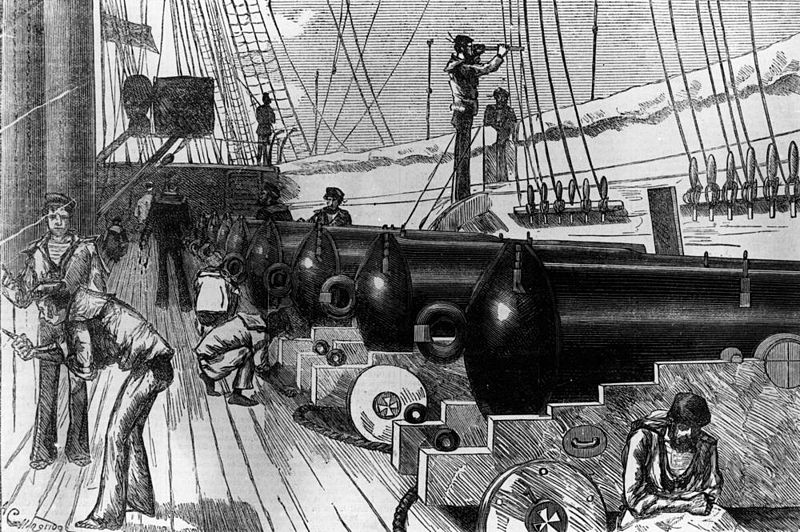
Gun deck of H.M.S. Wolverene, 1881. Copy of an illustration from the Town and Country Journal, 11th of June, 1881 p.1128. Artist's name Collingridge?.
The gig which had brought the late arrivals off was hoisted on board, and a curious appearance her bottom presented, justifying the previously-expressed remark of one Jack-tar, that she was "cruel hard boat to pull." She was covered with marine growth and barnacles, all the result of three months immersion, and this circumstance shows how badly the long stationary Wolverene needed her recent docking.
The command of the corvette during this last trip was of a divided nature. Captain Hixson was in effect Admiral of the squadron; Commander Lindeman had full control of the brigade, and managed everything as regarded the fighting of the ship ; while she was sailed by her own permanent staff of officers and men. These were- Lieutenant F. P. Taylor, R.N. (in command), Lieutenant G. S. Bosanquet, R.N., Lieutenant R. Smith, Chief Engineer Walker, Paymaster E. J. Thomas, Gunner J. Costello, and Boatswain J. M'Carthy. She carries 34 able-bodied sea-men, 3 quarter-masters, 7 stokers, 2 boatswain's mates, 5 boys, and several cooks had stewards. The commissariat arrangements for the cruise wore made and skillfully carried out by Mr. Thomas, the paymaster.
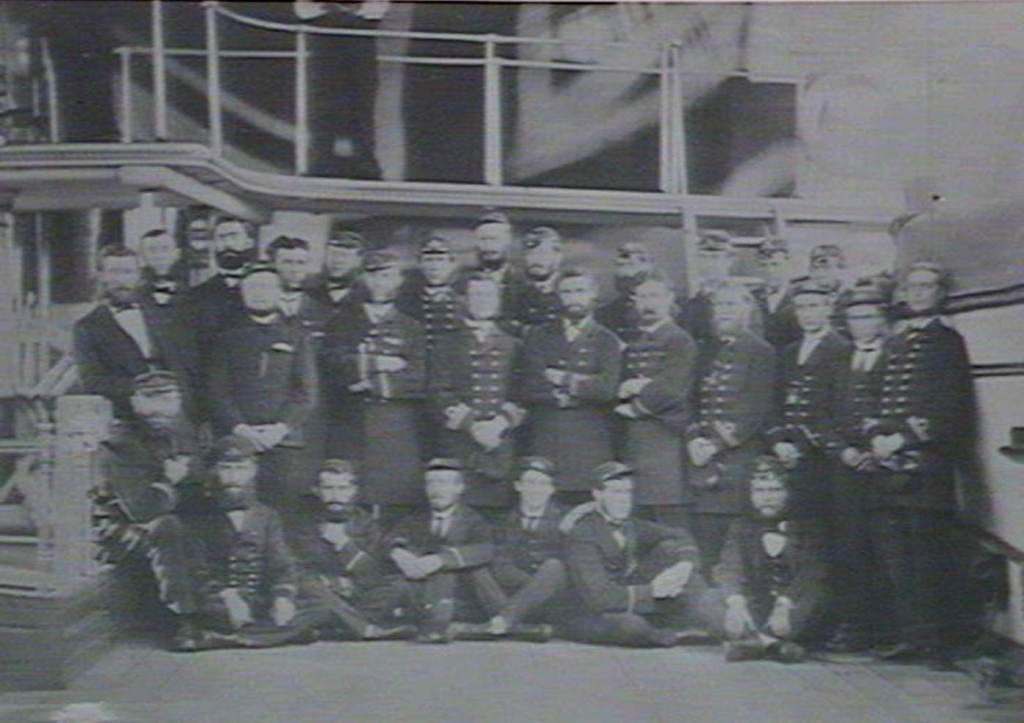
Early Group, Captain Lindeman on HMS Wolverine. Image No: Government Printing Office 1 - 12062, courtesy State Library of NSW.
Shortly before dusk on Saturday the Wolverene passed through Botany Heads, and anchored for the night a short distance up the bay, which some people consider one of the weak points in our harbour defences, but which is included in a general comprehensive scheme of defence lately worked out. The brigade had now settled down with regular naval discipline, and the old Wolverene looked livelier and more like a man-of-war than she has done any time these three years. Poop and forecastle, main deck and lower deck, were crowded, and the usual routine of service life was followed. Sentries wore posted at 8 o'clock, and at 9 o'clock, when the Commander went the rounds, he found everything satisfactory and the men all settled down into their places.
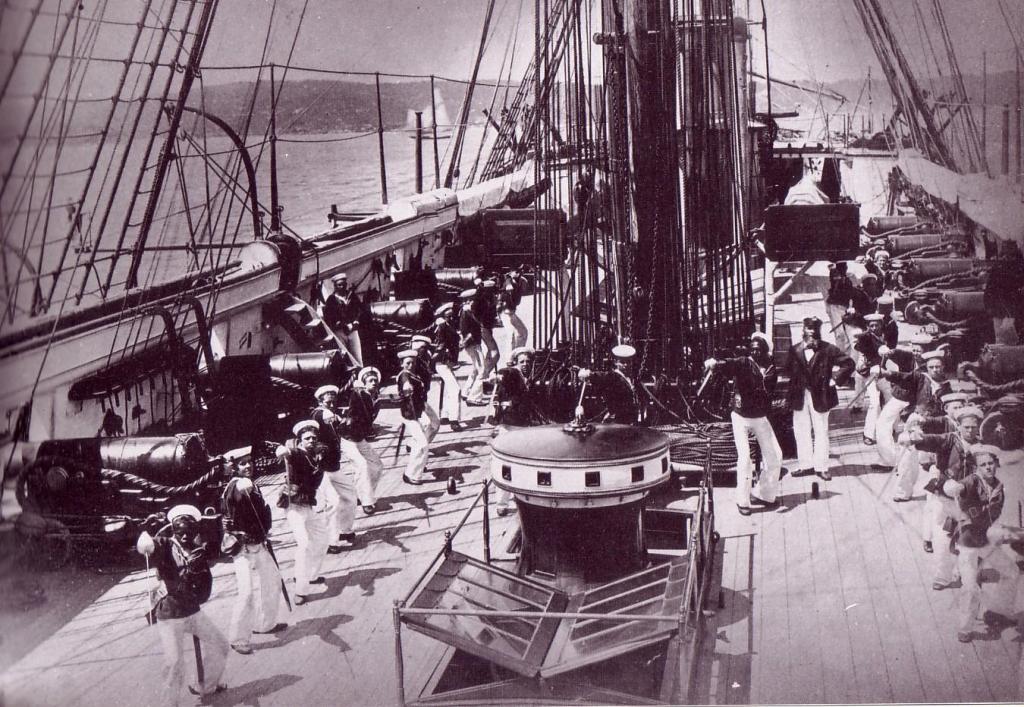
HMCS Wolverene: boys at cutlass drill, 1882, courtesy State Library of NSW.
A lot of them were abnormally merry, and after tea regaled their comrades with popular songs, sung very much out of tune; but for the most part their voices wore drowned by the music of the Naval Brigade Band, which played on the quarterdeck while the officers were at dinner. Of the 30 men who compose this band, no less than 23 reported themselves, and the bandmaster, Mr. J. Devlin, certainly deserves the utmost most credit for the excellence of the tuition ho has given them. Their repertory is large, it contains the latest music of special merit or popularity, and every selection was played in perfect time and with appropriate expression. Some of the instruments need renewing, but, as a rule, the tone is harmonious, and officers and men alike enjoyed the sweet strains which for a couple of hours floated over the tranquil waters of Botany Bay.
On Sunday morning the reveille was sounded at half-past 6 o’clock, and at 6 the men turned out. At 7 o'clock they went to quarters and did gun drill for an hour, profiting markedly by the clear directions given them by Mr. Rickwood -who held the position of drill instructor on the Nelson during the recent cruise of that vessel. The guns were cast loose, and broad-side and independent filing wakened the echoes to such an extent that the Botany people must have wondered if some hostile cruiser had not really arrived in these waters. The small-arm men were also drilled, and the different exorcises were so smartly carried out that Captain Hixson addressed a few words of approbation and encouragement to the Brigade. At 8 o'clock the guns were secured and the men went to breakfast; and after the meal the anchor was tripped, and the Heads were cleared at half past 9 o'clock.
Soon after 11 o'clock, when the Wolverene was abreast of the Sydney Heads, she signalled to the South Head station, " Have you any news of recent date about the enemy ? " and received an answer in the negative. She continued a northward course, and arrived and anchored in Broken Bay at half-past 1. After dinner the men went to quarters again, the roll was called, and service was held according to the Church of England ritual for Easter Sunday, the Rev. J. M. Hillyar, B.A., being the chaplain. Officers and men, clad in full uniform, stood in a square around an improvised pulpit, draped with the union jack ; and Mr. Hillyar, after a somewhat condensed service, preached a brief and impressive sermon, taking as his text Matthew, chap, xxviii, v. 6, "And the angel answered and said unto the woman, ' Fear not ye ; for I know that ye seek Jesus, which Was crucified.' "
The discourse was one appropriate to the occasion, and it was listened to attentively and reverently, although the attention of the congregation might well have been distracted by the puffing of pacing steam launches, or the gleam of an occasional yacht or sailing-boat wheeling in graceful curves around the vessel.
Broken Bay was full of craft, among them being the schooner-yacht Red Gauntlet, the Waitangi, the launch Ena, and a launch chartered by a band of jolly bachelors. After service no drill was performed. A small party went out with a seine net, and caught a few dozen bream and trevally, losing-owing to their want of skill at their Work-a shoal of garfish, which slipped through rents and skimmed over the top-rope until all had vanished. Others formed two crews, and had an exciting race in whaleboats, and some who remained on board went in for line-fishing. They secured little worth eating, however, the majority of the fish caught being small sharks and large sting-rays.

Ena II, courtesy State Archives of NSW
One of the Wolverene bluejackets rashly placed his barefoot on the back of one of the rays, and the fish promptly threw up his tail and inflicted upon him a sting that he will feel for some days. To relieve the pain the sufferer rubbed his foot with kerosene, the result being simply torture, until Dr. Evans directed him to bathe the injured member with hot water and apply bread-poultices to it. The only other cases of sickness in the Brigade were that a man of the No. 3 Company sustained a slight sunstroke; another of the same company had an attack of muscular rheumatism and one of the No. 2 Company sprained one of his ankles.
In the evening the band gave the usual concert, including as much sacred music as they know, and everyone sought his hammock or berth at an early hour.
Yesterday morning the usual routine was followed, and gun drill was performed even more smartly than on the previous day. At 8 o'clock, when the ensign was hoisted, the band played the National Anthem, according to the loyal custom which prevails in her Majesty's service, and then everything was got in readiness for commencing manouvres as soon as the remaining vessels of the squadron had reached the rendezvous. In the meantime the Brigade were set to man the yards, an operation which they performed with alacrity and fearlessness, different squads vieing with one another in the agility with which they reached their appointed stations and the smartness with which they obeyed Commander Lindeman's orders. They had never manned yards before, yet they did it in true man-of-war style. Previously the crew of the Wolverene had struck the top gallant masts and yards so smartly that the Brigade were put upon their mettle to emulate their mates for the time being.
The Ajax arrived shortly after 10 o'clock, and the Captain Cook was punctual in putting in an appearance at 11 a.m., but the hopper barges did not steam into sight until noon, by which time the squadron was underway, this being the hour fixed for departure from Broken Bay. They took up their position in the rear of the line, and the five vessels, the Wolverene leading, moved out to sea. The Juno and Neptune, especially the latter, travelled so slowly that the squadron did little more than crawl along, and the Waitangi, which left Broken Bay after it, skimmed past it with comparative ease, followed by the Red Rover.
_launch.jpg?timestamp=1377862686356) Firing was first commenced by the Wolverene, who blazed away with her stern chasers, and her challenge being promptly responded to by the other vessels-who acknowledged this signal more readily than they did some of the others-the squadron soon seemed to be engaged in a sharp fight, to the evident astonishment of the Swinger, which was a little way out in the offing, on her way to Sydney. She made a few signals, but soon gathered the significance of the demonstration, and left our navy, to its own devices. On approaching the Heads the order for independent firing of the big guns on the port side was given, and the Wolverene was enveloped in smoke, which had scarcely cleared away before a thundering broadside of seven guns on the starboard side renewed it. After this, firing was for half an hour almost continuous the bang, bang, and roar of the big guns, the whip-like crack of the Gatling in the main-top, and the splutter of the rifles on the poop and forecastle, making up a scene of smoke and apparent confusion, which gave one some idea of a sea fight, minus wounds and death. The confusion was only apparent, for whenever the heavy masses of powder smoke lifted, and the figures of the men loomed through them, and were seen at first dimly and then distinctly, moving rapidly about, sponging, charging, and discharging the guns, every man was at his own post doing his own work earnestly and effectively, the discipline maintained being equal to that of a man-of-war's crew. The Ajax and the Captain Cook fired in good style, the Neptune and Juno made themselves heard very frequently, and even the Red Gauntlet-which was some way ahead-became inspired with martial ardour and popped her gun oil occasionally.
Firing was first commenced by the Wolverene, who blazed away with her stern chasers, and her challenge being promptly responded to by the other vessels-who acknowledged this signal more readily than they did some of the others-the squadron soon seemed to be engaged in a sharp fight, to the evident astonishment of the Swinger, which was a little way out in the offing, on her way to Sydney. She made a few signals, but soon gathered the significance of the demonstration, and left our navy, to its own devices. On approaching the Heads the order for independent firing of the big guns on the port side was given, and the Wolverene was enveloped in smoke, which had scarcely cleared away before a thundering broadside of seven guns on the starboard side renewed it. After this, firing was for half an hour almost continuous the bang, bang, and roar of the big guns, the whip-like crack of the Gatling in the main-top, and the splutter of the rifles on the poop and forecastle, making up a scene of smoke and apparent confusion, which gave one some idea of a sea fight, minus wounds and death. The confusion was only apparent, for whenever the heavy masses of powder smoke lifted, and the figures of the men loomed through them, and were seen at first dimly and then distinctly, moving rapidly about, sponging, charging, and discharging the guns, every man was at his own post doing his own work earnestly and effectively, the discipline maintained being equal to that of a man-of-war's crew. The Ajax and the Captain Cook fired in good style, the Neptune and Juno made themselves heard very frequently, and even the Red Gauntlet-which was some way ahead-became inspired with martial ardour and popped her gun oil occasionally.
The land batteries then joined in, and the cannon at Middle, George’s, and South Heads, thundered defiance of the insignificant little steamers which represented the enemy. The Wolverene steamed up the Sound of the North Harbour, the Ajax and Captain Cook following her, while the Juno and Septima remained behind. From the Wolverene, the Mary, one of the invading vessels, could be seen to run into Middle Harbour, and the spray thrown up by exploding torpedoes could be seen over the headland east of Cobblers Beach. The Ajax then steamed up and captured her, an operation performed with comparative ease, seeing that the Mary had a crow of about six all told. The other steam launch passed under a heavy fire up the eastern channel, where certain torpedoes had been laid. These were to have been instrumental in vanquishing her, but somehow they failed to explode. Nevertheless, she was so dismayed by the preparations made for giving her a warm reception that she also surrendered and the sham-fight was over.
The guns on the different ships were then secured and covered. On board the Wolverene the men were beat to quarters, and Captain Hixson, addressing the Naval Brigade generally, and all who had taken part in the squadron manouvres, said that he fell he should be wanting in his duty if, before dismissing them to their homes, he did not acknowledge the very efficient manner in which they had manned and fought the Wolverene and the other vessels. He thanked the Brigade for the good discipline they had maintained, and the other forces for the cordial co-operation they had given him, which two things had enabled him to carry out the wishes of the Government. The Brigade had fought the guns and manned the yards in a manner that would not disgrace a man-of-war, and he felt sure that it an enemy were to come here and try to dispossess us of this country, he could go out and meet him in the manner in which Englishmen were wont to meet their foes. They had a line of defence, and as long as we could go out there and meet our enemies, he did not think we were in the position some of our friends thought we were in. He would not make a longer speech, but would content himself with thanking them again. (Cheers.) Cheers wore given for Captain Hixson, for Commander Lindeman, and the other officers of the Naval Brigade, and for Captain Taylor; and the proceedings terminated with cheers for the Queen. The men could not at once disembark, without incurring the expense of hiring watermen's boats, for the tender engaged to convoy them to Fort Macquarie was considerably behind her time in ranging alongside the Wolverene. ON BOARD THE WOLVERENE. (1885, April 7). The Sydney Morning Herald (NSW : 1842 - 1954), p. 3. Retrieved from http://nla.gov.au/nla.news-article13579326
Another instance of training, again including our area:
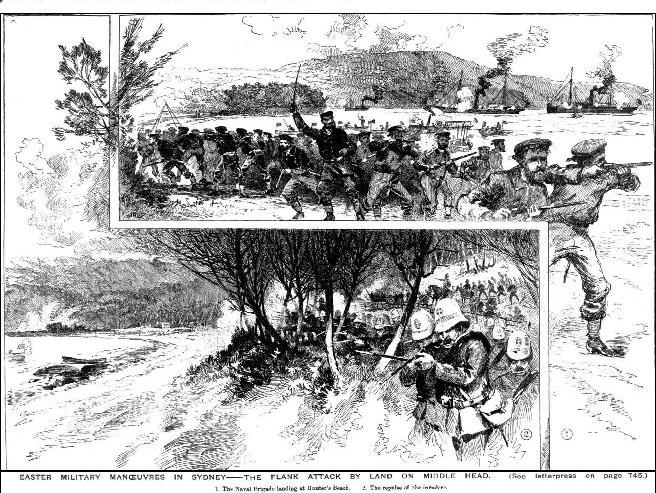 Easter Military Manouvres.
Easter Military Manouvres.
(See illustrations on pages 754 and 755.)
On the 3rd instant easy work was done at the headquarters camp, Paddington, Borne light drill being' done in the afternoon.
At the Middle Head encampment a similar state of things prevailed. In the marine department much more activity was displayed, and the torpedo boats did some very good work.
The Neptune engaged in shell practice, and a night attack was made to test the efficiency of the electric lights.
The effects upon the crew of so many converging search lights was said to be confusing; and the results attained on this occasion were favourable for the defence.
The 4th was the great day; the operations comprising an attack by the naval forces, which was repulsed by the local troops. At the beginning of the fight the assailants were the Naval Brigade, with the vessels Neptune, Thetis, and Captain Cook.
The defence was intrusted to the Naval Artillery Volunteers in the Wolverene, who at the outset formed part of the attacking forces ; the Avernus, torpedo boat, the Garrison Artillery, the Torpedo Corps, and the Field Artillery, Engineers, and troops, engaged in the protection of the guns. A false attack was to be made on the South Head by a landing made at Lady Bay.
The real objective was Middle Head; and the plan took in a land attack in the rear from the Sandspit and Hunter's Beach. This was to succeed partially, but was to be finally repulsed.
At half-past 2 the guns at the South Head opened on the Thetis and Captain Cook as they rounded North Head: the guns on Middle Head, George's Head, and Inner Head, firing in succession.
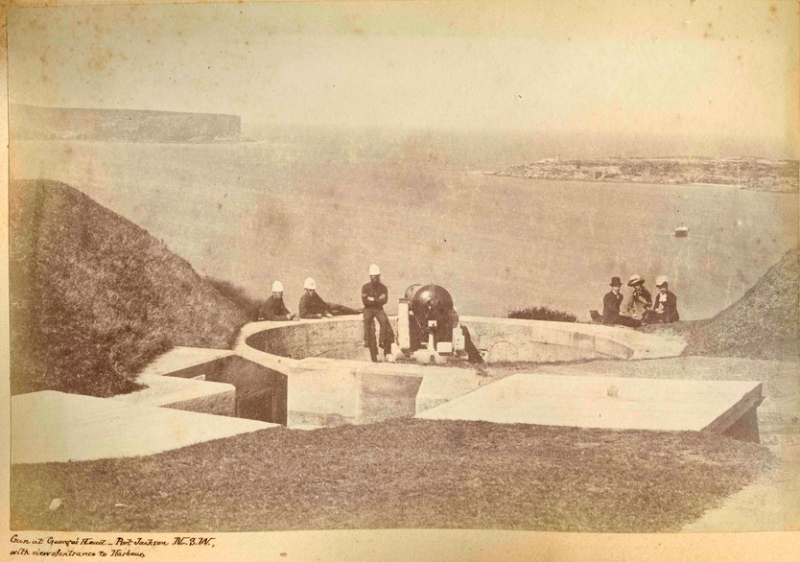
ANMM Collection Gift from the Royal Sydney Yacht Squadron, Image 00013762 and ANMM Collection Gift from the Royal Sydney Yacht Squadron, Image No: 00013762 [15] - first (above) is Gun at George's Head, circa 1880's and second (below) is Gun at Middle Head, also circa 1880's - note the ships in background.
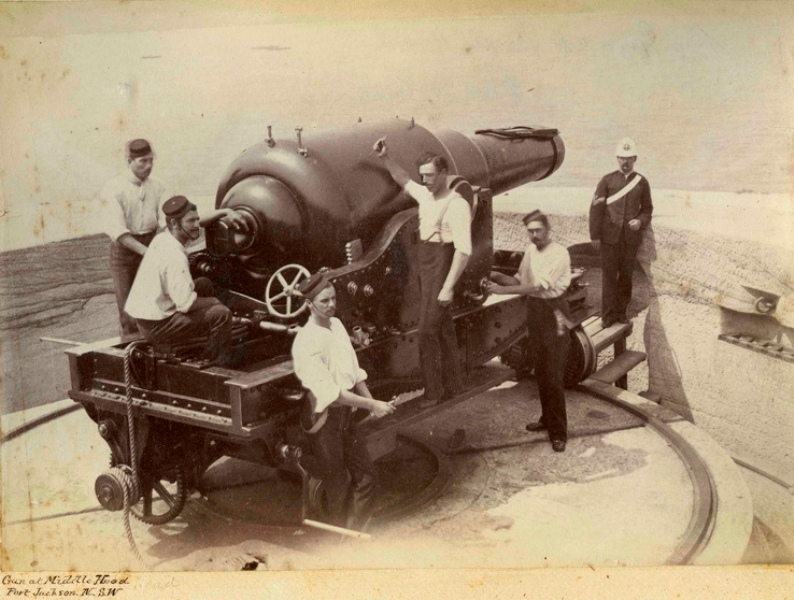
The enemy returned the fire. The attempted landing in Lady Bay failed. The Thetis and the Neptune forced their way past Middle Head, and after some warm work before and after debarkation, the defending troops wore forced back from the shore. The attack was pressed up the heights. But the defenders rallied on the (imaginary) redoubt, :and, being strengthened by some field guns, turned the tide of battle. The enemy were in turn driven down the hills to their boats losing a standard, and regained their vessels, being severely punished in retreat. The fight was all over by half-past 4.
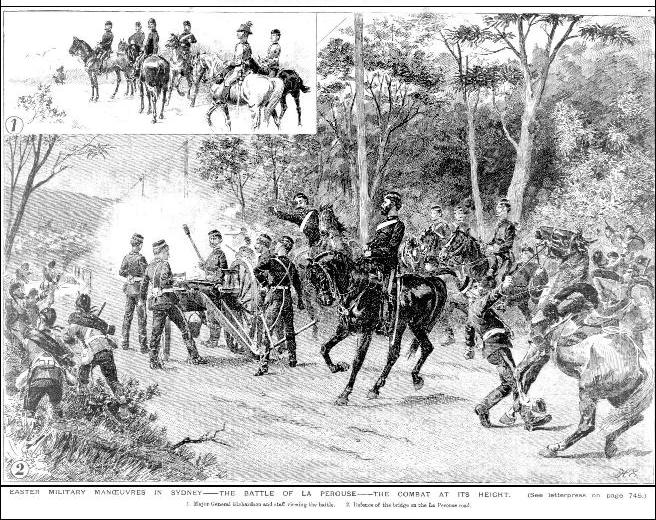 On Thursday, April 5, drill and big gun practice were engaged in at the Middle Head encampment, and on board the ships. But the land forces at Paddington did more serious work.
On Thursday, April 5, drill and big gun practice were engaged in at the Middle Head encampment, and on board the ships. But the land forces at Paddington did more serious work.
A force of artillery, the 4th Regiment, and a signal party, with heliograph and flags, went by rail to Hornsby, and then broke up into two parties for a sham fight over the broken ground near Cowan Creek.
Good military educational results were obtained, and the troops took train at Hornsby at 5.38, bat did not reach town till 8, the line being blocked.
Friday, April 6, was on off day at all the camps; the hard work of the previous day being welcomed at Paddington camp, to which the Governor mode an afternoon visit, and was entertained by the headquarters mess. Lord Carrington praised the camp for its orderliness and cleanliness, which sentiments were shared by Admiral Fairfax, also a visitor. The Governor then reviewed the troops in Moore Park in tho presence of a considerable number of spectators.
Practically, Friday, April 6, was the last day of the operations, and Saturday was breaking-up day for our military schoolboys.
Our illustrations represent the defence of the bridge by field artillery on the road to La Perouse, whence tho enemy advanced on Sydney ; tho commandor-in-chief, with his staff, watching tho battle at its height. Tho operations at Middle Head, in which the naval and military forces shared, are shown in two illustrations ; one representing the landing of tho invading party at Hunter’s Beach, and the other depicting their final repulse when compelled to take to their boats.
The experiment, begun some time ago in the German infantry, of doing away with socks and keeping the foot soldiers' feet well greased, has proved thoroughly successful. To say nothing of tho economy of the plan, the men march easier, and, generally speaking, show few blisters. So, too, lifting the foot high; the regulation, step now is said to make the most awkward Pomeranian or Hanoverian peasant fairly sure-footed, while before its adoption 25 per cont, of such men would stumble in a charge over rough ground, and about 10 per cont, fall.
On page 26: EASTER MILITARY MANOUVRES IN SYDNEY-THE FLANK ATTACK BY LAND ON MIDDLE HEAD. (See letterpress on page 745.) 1. The Naval Brigade landing at Hunter's Beach. 2. The repulse of the invaders. On page 27: EASTER MILITARY MANOUVRES. IN SYDNEY-THE BATTLE OF LA PEROUSE-THE COMBAT AT ITS HEIGHT. (See letterpress on page 745.) 1. Major- General Richardson and staff viewing the battle. 2. Defence of the bridge on the La Perouse-road.
Easter Military Manoeuvres. (1888, April 14). Australian Town and Country Journal (NSW : 1870 - 1907), p. 17. Retrieved from http://nla.gov.au/nla.news-article71096579
Naval Brigade Jubilee
Exactly 50 years ago our Naval Brigade was founded. For half a century its members have stood on the harbour front, ready to do their share in the defence of sunny New South Wales. That being so, the presentation of long service medals this afternoon by the Admiral will assume the form of a jubilee celebration. Men will be there in the ranks who have been connected with the voluntary defence of the State for 30 and 40 years, and the 'long service" medals will not be the only decorations they will wear, for the men of the Naval Brigade have served the Empire in China, In the Soudan, in South Africa, and in other parts of the world.
The Naval Brigde.- We believe- that the Government is now organising a force for naval purposes and that Mr. Hixson, inspector of harbour and lighthouses, will be appointed to the command.
This unpretentious paragraph, taken from the "Sydney Morning Herald" of May 1, 1863, was the first public intimation of the intention to create a naval defence force for New South Wales, and the announcement was duly authenticated the following day, for the "Government Gazette" of May 2 contained a proclamation, given under the hand and seal of His Excellency Sir John Young, Bart, K.C M.G ,Captain-General and Governor-In-Chief of the Colony, and Vice-Admiral of the same, in the year of our Lord 1863, and in the 26th year of her Majesty's reign, to the effect that it was deemed expedient to form a Naval Brigade, consisting of three companies of 40 men each. There was no war scare on at the time, and the last muster, at the Queen's birthday review, found Captain Hixson with 18 stalwarts, making a little blue patch among the redcoats in the Domain. Lieut. Moodie was second in command, and, being a salt of the old school, with many voyages to and from Australia to his credit, he had his own way of giving orders. When the company sagged in the centre he yelled out,, "Form up midship," and when he desired them to "double," he cried out, "Heave ahead."
But the men, mostly ex-seamen, were well up in the vernacular. And the movement grew. By June the brigade was 85 strong, by October 167; next year 200 odd, and at the Queen’s birthday review of 1876, they mustered 358-all told. Since then the numbers have fluctuated. Each "war scare" saw men flocking to the standard. Each period of fancied security saw a parsimonious Government cut down the sinews of war. In 1885 the "Russian" scare was responsible for the Brigade Increasing to 600 men carefully drilled, and roused round day and night to get them fit for the expected summons." And visitors from the country, admiring the business like demeanour of the men, declared that "Sydney is all right as long as those fellows are on deck."
It was in 1882 that the Naval Artillery-Volunteers emerged, under Commander Bosanquet, the leading spirit being A.B Fred Cavill, who became a warrant officer, then paymaster. The members had to provide their own uniform, and also paid a subscription of a pound a year for the privilege of defending their country. They even built their own boats.
For a long time captious critics had been pointing out that this alleged "naval" force had no warship. But this reproach was removed by Sir Henry Parkes, who in 1882 announced that H.M.S. Wolverene, which had been relieved by H.M.S. Nelson as flagship, was to be handed over as a free gift to New South Wales from the imperial authorities. The official transfer was made on January l8, 1882, by Rear-Admiral Wilson to Lord Augustus Loftus, who passed it on to Sir John-Robertson. The band played, and a salute of 17 guns were fired from H.M.S. Emerald.
Despite the self-denying patriotism of the naval forces, they were for years the most maligned men on the face of the continent. Land-lubbers, whose name was legion, inundated them with advice, while an old scrap book now in the possession of Lieutenant Spain contains scores of letters to the editors of various Journals pointing out their defects. One kind critic said: “The force is a burlesque," and referred to their cannon as "old-fashioned bulldogs, which they drag round Moore Park on Queen's Birthday, and which are about as effective as so many Chinese gongs." Another hinted that "they were too careful of their white ducks," and a third urged "the Introduction of matchlocks and leather-jacketed cannon as the complement to it." And, ignorant of the magnificent work of the Naval Brigade in the trenches before Sebastopol, in the Gold Coast, India, China, and other places, another asked, "if the Naval Brigade system had ever been proved in war?" It was even written that "the Wolverene still holds together, and if southerly weather does not continue long may yet remain to be a coffin for our naval brigade."
The limit was reached when, in a headquarters general order, the brigade was complimented on its "soldier-like" appearance; to which an able seaman rejoined, "The sojer. who wrote it knowed no better."
But these pinpricks and comments only served to knit officers and men more closely together. However, when in 1864, the Hon. member for Maneroo in the Legislative Assembly referred to them as well-dressed-up dolls, a resolution was passed by a meeting of the men that they should resign and deliver up their arms to the Government. But this was never carried out, and the testimonies to their worth and tributes to their efficiency far outweighed the criticism of the grumblers. In 1875 Commodore Chapman, after an Inspection officially Informed the Governor, Sir Hercules Robinson, that the naval brigade "reflected credit on Captain Hixson for their smartness, activity, and good discipline " In 1887 a competent authority, after the brigade was inspected by Lord and Lady Carrington, and Lord and Lady Brassey, pronounced them "practically the best of the volunteer militia corps;" while Admiral Fairfax, after witnessing them at small-arm, gun, and cutlass drill, said that "any captain In Her Majesty's service might be proud to command such a crew."
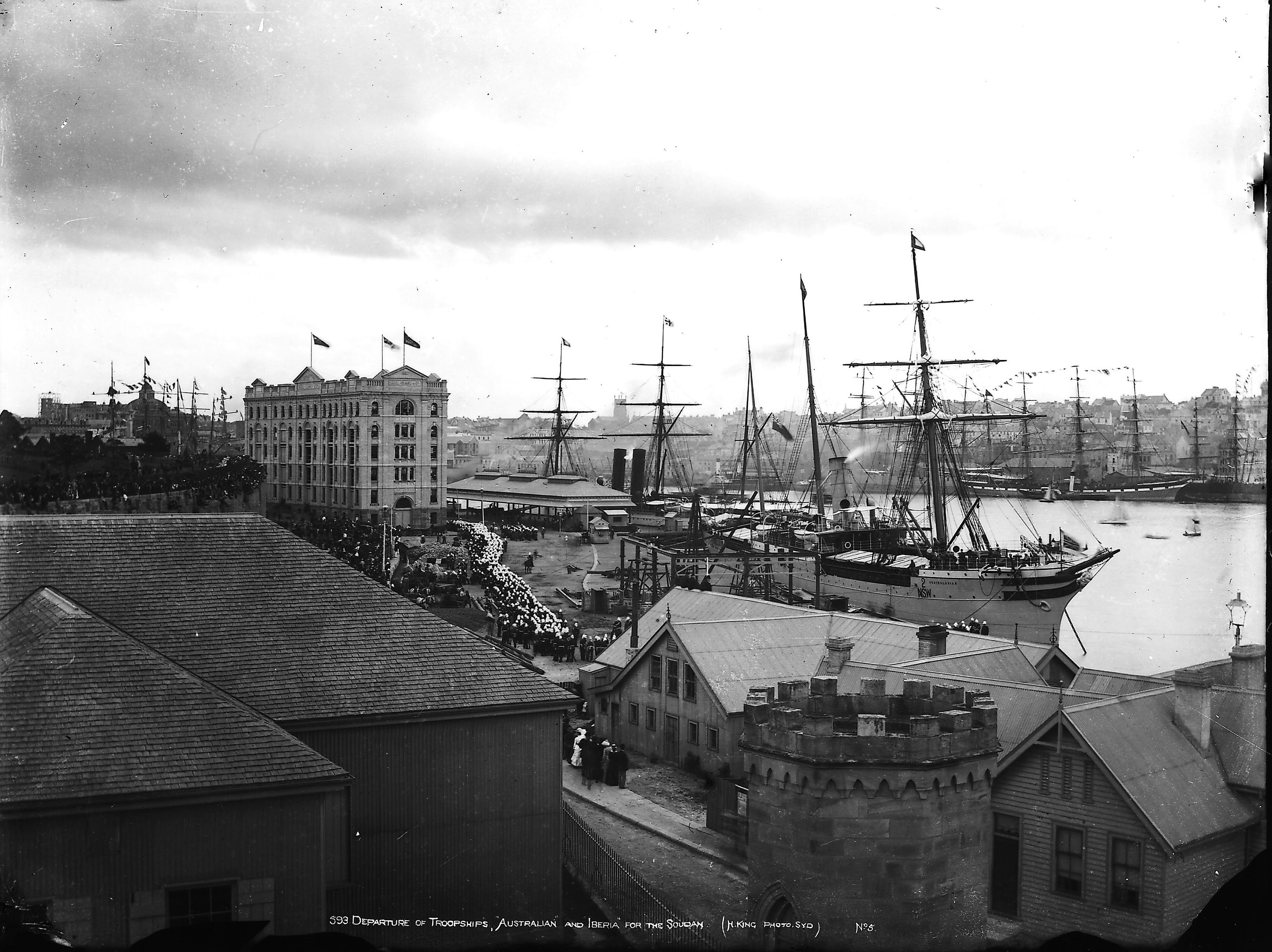
Above: Ships departing for the Sudan with troops, March 3rd, 1885. Henry King Image courtesy Powerhouse Museum.
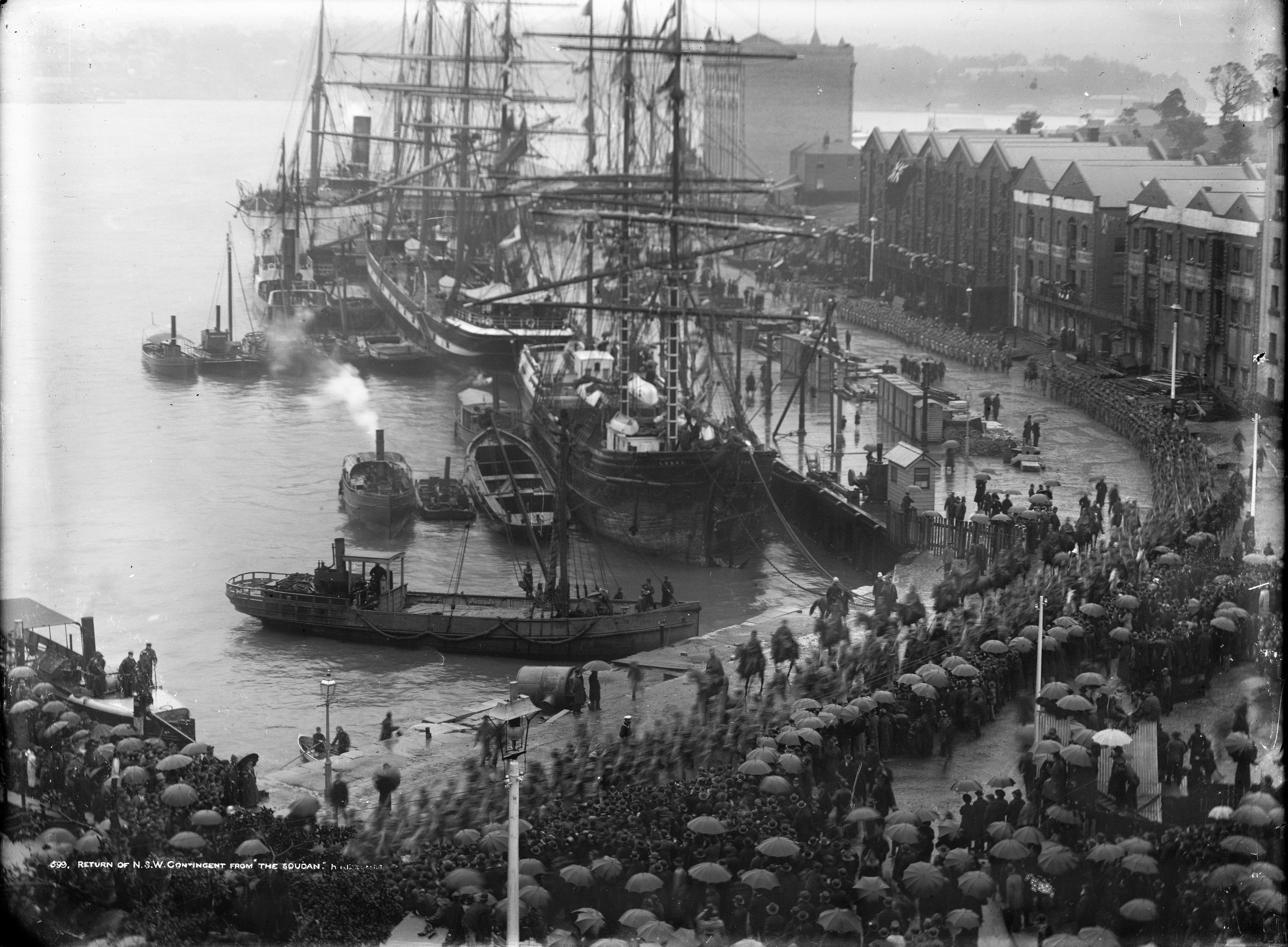
Above: Ships departing for the Sudan with troops, March 3rd, 1885. Henry King Image courtesy Powerhouse Museum.
Still their record for efficiency does not treat on mere official compliments. Deeds, not works, speak for them. As early as 1860 they had quite held their own in artillery contests, and marksmanship. In their cutters they were invincible. Two cutters from the brigade in the same year defeated the picked crew of H.M.S Brisk. In the harbour regatta that celebrated 79th anniversary of the colony, they defeated the pick of H.M.S. Falcon and H.M.S. Salamander. After defeating the cream of the Royal Navy cutters, the brigade, with a cutter of 10 men, accepted a challenge from a cutter of 12 men from U.S.S. Kearsago, and won easily. The records of the brigade contain a splendid succession of victories at rifle shooting, rowing, and even In hand contests. And there are also many diverting accounts of most realistic sham fights, with attacks on the Heads, Botany Bay, Fort Macquarie, and Fort Denison. One of the best was that of Easter, 1885, in which the alleged invading fleet consisted of the Naval Brigade on the Wolverene, Ajax, Captain Cook, and the barges Juno and Neptune, with the Naval Artillery Volunteers on board. All the available forces of the colony were massed to repel the Invader. Broad-sides belched from the warship, the gatlings worked overtime, while the full force of rifle-men on the decks kept up a roaring fusillade. But the shore batteries riddled the invaders: some were torpedoed, some ran ashore, and some were captured, and amid much rejoicing the city was saved.
These sham fights were only a forecast of the real thing. About 40 of the naval men participated in the Soudan campaign. Many volunteered for South Africa, and the first colonial killed was Chief Petty-officer T Griffen. In China the 200 bluejackets and 20 marines from Sydney won the highest possible praise from the Commander-In-Chief of the allies. And the Naval Brigade is still ready when the Empire calls. With the reorganisation resultant upon federation, and the compulsory training scheme, their name changed, but they are the same in spirit. There are in Newcastle and Sydney 267 Royal Australian Naval Reserve. M section; 220 R.A.N.R., O section :mid 1000 naval senior cadets; the whole under the district naval officer Commander Brownlow, who was one of the contingent that went to the Soudan.
For 25 years representations have been made for the granting of the hard-earned medals to these patriots but some Admiralty regulation stood in the way. At Rushcutter’s Bay this afternoon Justice will at last be done them. NAVAL BRIGADE JUBILEE. (1913, May 17). The Sydney Morning Herald (NSW : 1842 - 1954), p. 24. Retrieved from http://nla.gov.au/nla.news-article15421122
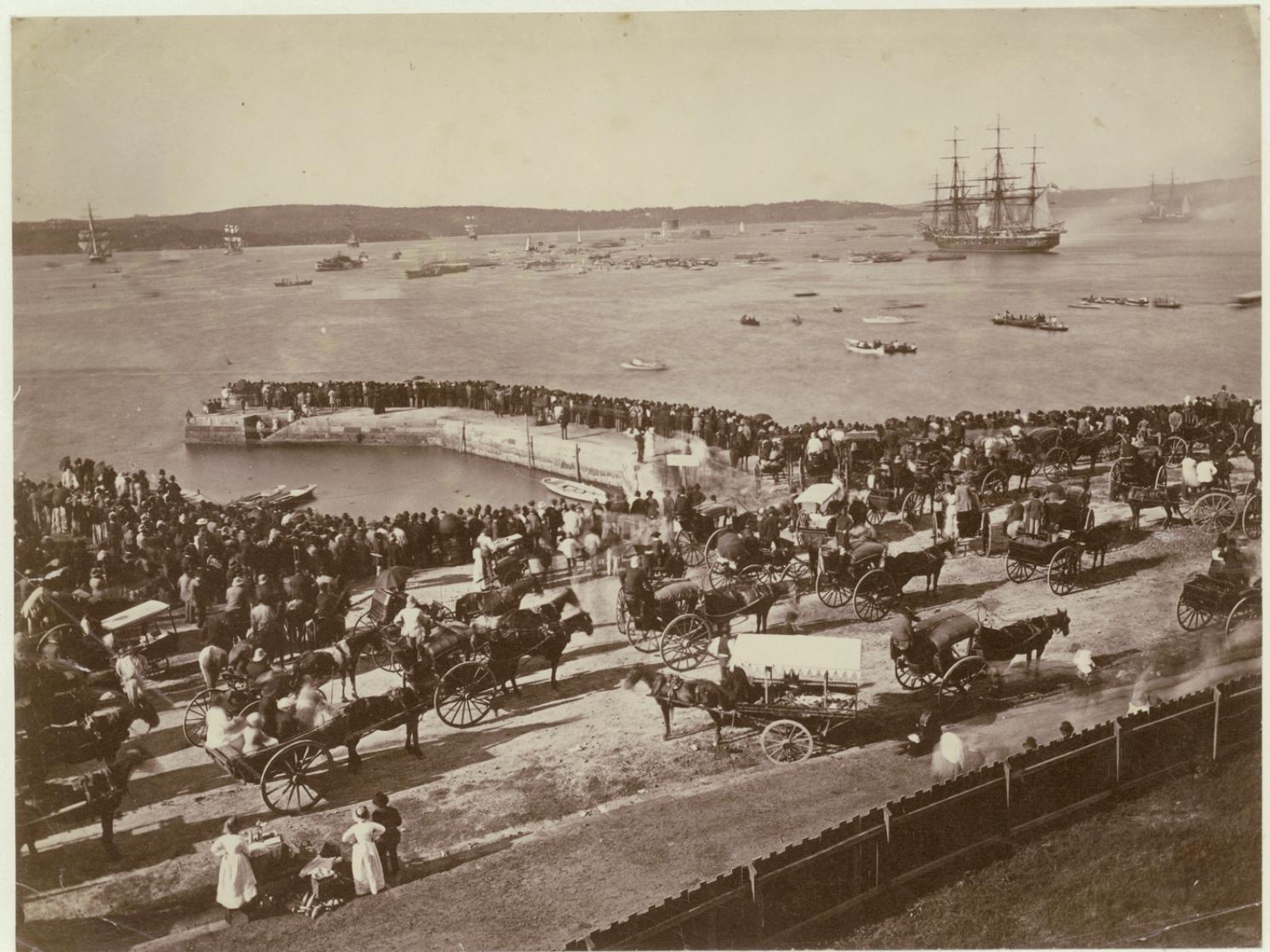
Sham Naval fight, Detached Squadron, Sydney, 1881. Image No. a325013, courtesy State Library of NSW.
References and Extras:
1. Trove - National Library of Australia
HMS Wolverine was built at the Woolwich Dockyard and launched at Woolwich on 29 August 1863. After serving in the North America and West Indies Station in the 1860s, she was commissioned as the flagship of the Australia Station on 7 September 1875, under the command of Commodore Anthony Hoskins.
During its service Wolverine was present for the Royal Navy's Detached Squadron world cruise in 1881 when the princes Albert and George undertook naval training. The Wolverine left Sydney Harbour at the same time as the Detached Squadron on 10 August 1881, with Commodore John Wilson, Commander-in-Chief of the Australia Station, her destination being Brisbane and then New Guinea. On board was the scientist Nicholas Miklouho-Maclay who was to continue scientific studies in Brisbane and New Guinea. His knowledge of the people of New Guinea was used to assist Commodore Wilson in a punitive expedition to apprehend natives concerned in a murder which took place at Kalo on the South coast.
Wolverines service came to an end was replaced by HMS Nelson and paid off in 1882 at Sydney. She was presented to the Colony of New South Wales as a training ship for the New South Wales Naval Brigade and New South Wales Naval Artillery Volunteers — challenging "enemy" ships at Sydney heads and "attacking" coastal and harbour fortifications. The ship was decommissioned in 1892, sold to a private firm (Peter Ellison, Sydney) for £2,200 in August 1893 and with the engines removed was used as a hulk.
After refit and conversion to a barque, she commenced service as a merchant vessel. On a voyage from Sydney to Liverpool, England she sprung leaks and returned to Auckland for repairs, however upon docking she was found to be unfit. She was sold to G. Niccol, Auckland, for £1,000.
HMS Wolverine (1863). (2013, August 14). In Wikipedia, The Free Encyclopedia. Retrieved from http://en.wikipedia.org/w/index.php?title=HMS_Wolverine_(1863)&oldid=568440899
THE WOLVERENE.
The ex-warship Wolverene, an erstwhile flagship on this station, is now lying in Neutral Bay ready to proceed on her first voyage as a merchantman. She has been chartered by Messrs. Gibbs, Bright, and Company, and is loaded with shale and tallow for Liverpool. Mr. Peter Ellison has spared no trouble to make the vessel a staunch and safe cargo carrier, and as she had the reputation of a fast ship when in the navy, her defader the red ensign will be watched with interest.

The above sketch shows the 'old wolf ' as she lies in Neutral Bay .and, save for the absence of her funnel, guns, and hammock cloths, externally her appearance has been little changed. Captain Steinmann is in command of the Wolverene. THE WOLVERENE. (1895, February 19). Evening News(Sydney, NSW : 1869 - 1931), p. 3. Retrieved from http://nla.gov.au/nla.news-article108070457
THE DETACHED SQUADRON.
The vessels of the Detached Squadron presented a busy scene yesterday, for from an early hour preparations for departure in the afternoon were in progress. A few visitors were allowed on board to bid their friends among the officers good-bye, but each vessel was rigidly closed to the general public. His Excellency the Governor paid a farewell visit to the Inconstant and the Bacchante, and in the afternoon the Mayor of Sydney and a number of the Aldermen visited the different ships and wished the captains a pleasant voyage. When on the Bacchante they were received by their Royal Highnesses Prince Edward and Prince George of Wales, to each of whom little Master Harris, son of the Mayor, presented a lovely bouquet of flowers. The Admiral, who is now able to take exercise on deck, is nearly well again, and at noon yesterday the signal was made from the flagship-" The squadron will proceed to Brisbane and Yokohama, and will probably touch at Fiji.”
What is to become of the mails sent onto Auckland was not said, but they will probably be sent in pursuit of the squadron, and reach it months hence, as the route now projected is likely enough to be changed when the vessels reach Brisbane. The stay at Moreton Bay will be short, probably only long enough to acquaint the Admiralty with the state of Lord Clanwilliam’s health, and to receive definite instructions about visiting Fiji.
Fairer weather could not have prevailed for the beginning of a sea voyage than that which favoured the Detached Squadron yesterday. As the hour for leaving port drew near, visitors disappeared from the decks, each vessel was got under steam, with cable shortened, and every officer was at his post. At a few minutes to 4, the Inconstant signalled, " Single column line ahead, close order," and at precisely 4 o'clock the flagship, having weighed anchor, moved slowly ahead towards Fort Denison. The light wind and flood tide swung the vessels with their heads to seaward, so that little manouvering was necessary to get them into the desired line, and this was done almost before they had quitted Farm Cove. The Carysfort ranged up close in the wake of the Inconstant, then followed the Bacchante, which received around of cheers from some hundreds of sightseers on the Orient steamer as she passed. The Wolverene, Cleopatra, and Tourmaline followed in the order named, and passing Fort Denison the flagship sent a signal aloft indicating that the Admiral intended to proceed at a speed of 12 knots. An increased velocity was forthwith noticeable on the part of each ship, and the last of the line passed Fort Denison at 4 20 p m, the band of each ship keeping up a succession of lively airs.
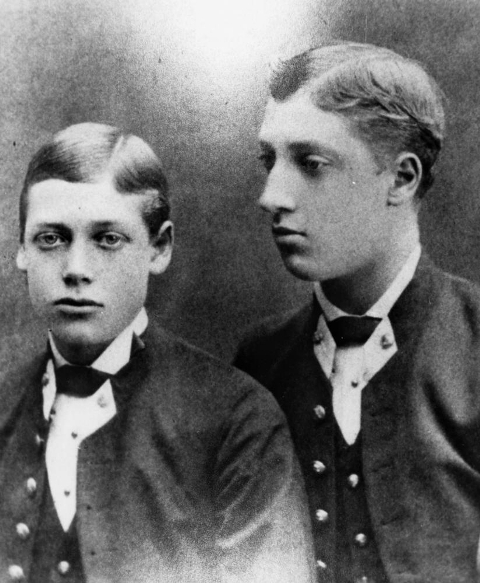 Right: Prince Albert and Prince George of Wales in Brisbane, August 1881, John Oxley Library, State Library of Queensland Neg: 68314
Right: Prince Albert and Prince George of Wales in Brisbane, August 1881, John Oxley Library, State Library of Queensland Neg: 68314
A considerable degree of nautical skill was evinced by the speedy way in which the vessels ranged in line, and though the Bacchante, as she felt herself moving, became a little unruly, she was soon got under control The procession down the harbour was a pretty and novel spectacle-one that was worth going far to see. The Squadron took a wide sweep round Bradley's Head, and passed out by the eastern channel, with point of water under oven the Inconstant which draws 26 feet aft and 21 feet 6 inches forward. Farm Cove was fairly alive with sailing boats, rowing boats, and steam launchs as the time for departure approached. The are around Mrs Macquarie's Chair was black with people, and a number of steam yachts and steamers accompanied the stately line of warships to the Heads. Among them were the Government steamer Nea, in which were Lady Augustus Loftus, his Excellency Sir Arthur Kennedy, Lieut Nathan, ADC, and several ladies , the Pacific, with the Mayor and Aldermen of Sydney, and a number of other gentleman on board the Commodore, Thetis, Prince of Wales, Alathea, Quandong, and Swansea. Cheers were exchanged between the crews of the departing vessels and those on the steamers, and amid the waving of handkerchiefs and flags from the friends they left behind, the tender strains of ' Auld Lang Syne," and heartily shouted good wishes, the squadron passed out of Port Jackson, and took its course northward. The journey to Cape Moreton will be made under sail, and may be expected to occupy about four days.
The Wolverene, Commodore Wilson, will accompany the squadron to the latitude of Brisbane, and then voyage to New Guinea. This will be the Wolverene's last cruise, as Commodore Wilson's time (three years) will expire in December next. There is, we understand, some probability of the Wolverene remaining here, as the Imperial Government has been asked to make a gift of her to the Government of this colony for the use of the Naval Brigade.
Baron Maclay, the distinguished naturalist, has gone to New Guinea in the Wolverene, for the purpose of continuing his scientific labours there. And it is further expected that his knowledge of the New Guinea people will be of assistance to Commodore Wilson in securing the real offenders in the murder which took place at Kalo, on the south coast of New Guinea. The biological station at Watson's Bay is now ready for use by scientists.
See; PICTURESQUE NEW GUINEA. WITH AN HISTORICAL INTRODUCTION AND SUPPLEMENTARY CHAPTERS OF THE MANNERS AND CUSTOMS OF THE PAPUANS; ACCOMPANIED WITH FIFTY FULL-PAGE AUTOTYPE ILLUSTRATIONS FROM NEGATIVES OF PORTRAITS FROM LIFE AND GROUPS AND LANDSCAPES FROM NATURE BY J. W. LINDT, F.R.G.S. Published 1887 Full Book HERE
It transpires that during the Inconstant’s stay here about 80 men have deserted from her, and the other ships have also lost a large number of men.
THE DETACHED SQUADRON. (1881, August 11). The Sydney Morning Herald (NSW : 1842 - 1954), p. 5. Retrieved from http://nla.gov.au/nla.news-article13492269
THE YACHT RED GAUNTLET.
Yachting in Victoria has made rapid strides within the past few years, and the Victoria Yacht Club numbers amongst its members several wealthy gentlemen,- who, imbued with a love of the amusement, have obtained vessels that would be a credit to any yacht club in the world. Prominent amongst the vessels to which we allude is the celebrated Red Gauntlet, a yacht owned by Messrs. C. and E. Millar, the elder of whom is commodore of the club. The Red Gauntlet was built at Lymington by Mr. Inman, a celebrated yacht builder, to the order of Mr. Haig, an English gentleman, who subsequently sold her to Mr. Langtry, the husband of the lady known in English society as the Jersey Lily. The yacht eventually fell into the hands of a Mr. Balfour,' who brought her out to the colony, and, he dying in Sydney, she fell into the hands of her present owners. The yacht is 148 tons register, her dimensions being 101 feet over all and 19 feet beam. She is rigged as a fore-and-aft schooner, and is a beautiful model, her lines being exceptionally fine, and she is a very fast vessel in a good breeze. The yacht is kept in beautiful order, and the visitor on stepping on board is struck by the neat appearance of everything on deck. Her cabin accommodation, though necessarily limited, is most complete, and the fittings are the perfection of good taste, and she is just what a gentleman's yacht should be.

The Red Gauntlet was recently re-fitted in Melbourne her owners sparing no expense in making her all that could be desired, and when the work had been finished a party proceeded in her for a somewhat extended cruise. She left Melbourne on the 3rd January, and after paying a visit to several of the islands in. Bass's Straits, she proceeded to Hobart, where she arrived on the 11th January, and was very much admired by the nautical authorities of that place. After remaining there several days she returned to Melbourne, and on the voyage back encountered some exceptionally heavy weather, in 'which she proved herself to be a magnificent sea boat. The Red Gauntlet is not intended as a racer, but there can be no doubt that with her fine lines she would in a breeze of wind give a very good account of herself. With the exception of the steam yacht Cushie Doo, which is 358 tons, the Red Gauntlet is the largest vessel in the V. Y. C. fleet. THE YACHT RED GAUNTLET. (1882, March 22). Illustrated Australian News (Melbourne, Vic. : 1876 - 1889), p. 36. Retrieved from http://nla.gov.au/nla.news-article63186028
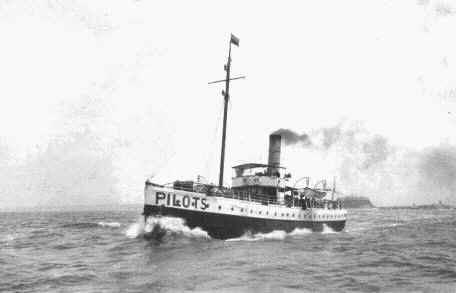 An iron screw steamer, Ajax (right) was originally built and launched in 1874 as a tug boat for the N.S.W. Government by Morts Dock & Engineering Company in Balmain, N.S.W., Australia. She had one deck, one spar deck and a tonnage of 344 gross and 189 net. She had a length of 128.7 ft., a width of 21 ft. and a depth of 12 ft. Her 2-cylinder (20" and 38.5") inverted steam engine with overhead crankshafts attained some 72hp.
An iron screw steamer, Ajax (right) was originally built and launched in 1874 as a tug boat for the N.S.W. Government by Morts Dock & Engineering Company in Balmain, N.S.W., Australia. She had one deck, one spar deck and a tonnage of 344 gross and 189 net. She had a length of 128.7 ft., a width of 21 ft. and a depth of 12 ft. Her 2-cylinder (20" and 38.5") inverted steam engine with overhead crankshafts attained some 72hp.
HMS ss Swinger - H.M.S. Swinger, screw composite gunboat, .1 guns, 430 tons.
HMS Thetis was a Briton-class wooden screw corvette built for the Royal Navy in the late 1860s. In Australia: Pilot Steamer THETIS The State Records NSW states - "The pilot steamer Thetis, built in 1868 for the New South Wales Department of Public Works. In 1871 the Thetis was placed in temporary service as Sydney's Pilot Steamer until 1877."
This Thetis Pilot Steamer photograph comes from an album that belonged to Edward Hungerford and contains images of shipping and street scenes around Sydney from the 1880s. Edward Hungerford was born on 10 June 1863 in Cahirmoore, Ireland (County Cork), the son of Henry Jones Hungerford and Mary Boone Cowper. Hungerford migrated to Australia around 1882 and became a long-serving member of the Royal Sydney Yacht Squadron. He died 24 June 1956 in Newtown, Sydney. ANMM Collection Gift from the Royal Sydney Yacht Squadron. Image No: 00013762 [78]
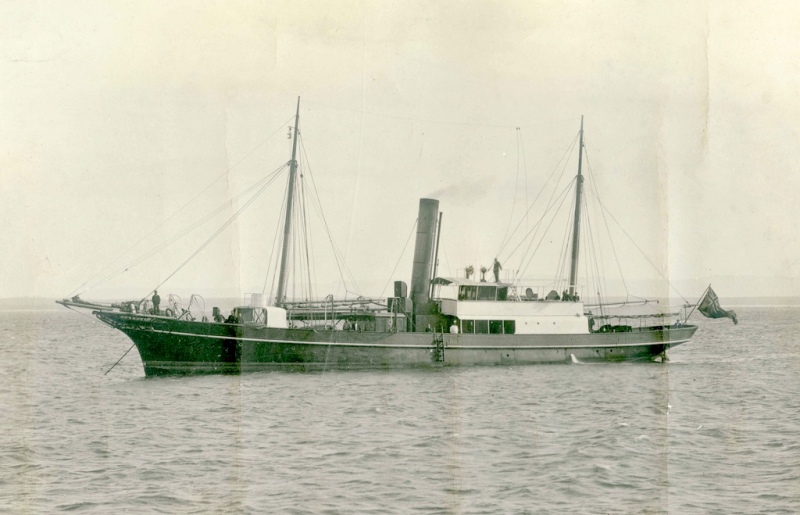
Thetis - Pilot steamer
HMS Juno - JUNO Wooden Screw Corvettes - The Surveyor to the Royal navy during 1863 to 1870, Sir Edward Reid was the designer of these Wooden Screw Corvettes, HMS Juno and HMS Thalia. They were designed to carry troops with the accommodation arranged with the Soldiers on the Lower deck, and the Sailors on the upper deck.
HMS Thalia was the last ship to be built at Woolwich Royal Dockyard, laid down in 1866 and launched 14th July 1869 and completed for the Royal Navy in May 1870. Displacement: 2240 tons, Crew 200, Speed: 11.13 knots. Armament: Two 7 -inch MLR and four 64 pounder. later being rearmed with six 64 pounders.
HMS Juno was built by Deptford Dockyard and laid down in 1866, launched on the 28th November 1867 and completed in May 1868. Displacement: 2083 tons, Crew 200, Speed: 10.53 knots. Armament: Two 7 -inch MLR and four 64 pounder. later being rearmed with eight 64 pounders. The seventh “JUNO” was an 8-gun screw corvette, launched at Deptford in 1867. She was of 2240 tons, 1380 horse-power, and 10 knots speed. Her length, beam, and draught were 200ft., 40ft., and 18ft. The box-like shape of this vessel led to her being nicknamed the “Tea Chest.” In 1878 the “Juno,” commanded by Captain J.A. Poland, was engaged in watching a Russian squadron in the Far East during a period of strained relations. In 1887 the “Juno” was sold.
Captain Cook – Pilot Vessel
New Pilot Steamer FOR PORT JACKSON.
The pilot steamer Captain Cook, an illustration of which, taken from the sail plan of the vessel, appears in this issue, was launched from Mort and Company's Shipbuilding Yard on December 7, when the ceremony of christening the vessel was undertaken by the Earl of Jersey. The Captain Cook is said to be the finest vessel of its kind ever built in Australasia. She is 155ft long, 25ft beam, and 15ft depth of hold, flush decked, with a bridge amidships, with a raised forecastle, clipper' bow with a clean entrance, an elliptic stern with a nice run aft, which give her a very taking appearance. Her rig is that of a schooner. The vessel is fitted with steam windlass and steam and hand steering gear. The cabins for the commander and the pilots are commodious, well-ventilated, and lighted. In the forecastle the crew have comfortable quarters allotted to them. Her engines are on the triple expansion principle, the respective diameters of her cylinders being 16in, 25in, and 42in, with a 2ft 6in stroke; steam is generated in a boiler of the ordinary marine type, 14ft 11in diameter, and 11ft 6in long, and the indicated h.p. of her engines is set down at 750. In addition to other improvements she has an electric search light of 12,000 candlepower, and a powerful steam fire pump, capable of ejecting 36,000 gal of water per hour, through a 1 ½ in nozzle to a height of 190ft. The Captain Cook is at present having her boiler and engines fitted, and will soon be handed over the Government. Captain Creer will take command. The New Port Jackson Pilot Steamer Captain Cook, Launched at Sydney on December 7. (See letterpress on this page.) New Pilot Steamer. (1892, December 24). Australian Town and Country Journal (NSW : 1870 - 1907), p. 31. Retrieved from http://nla.gov.au/nla.news-article71207909
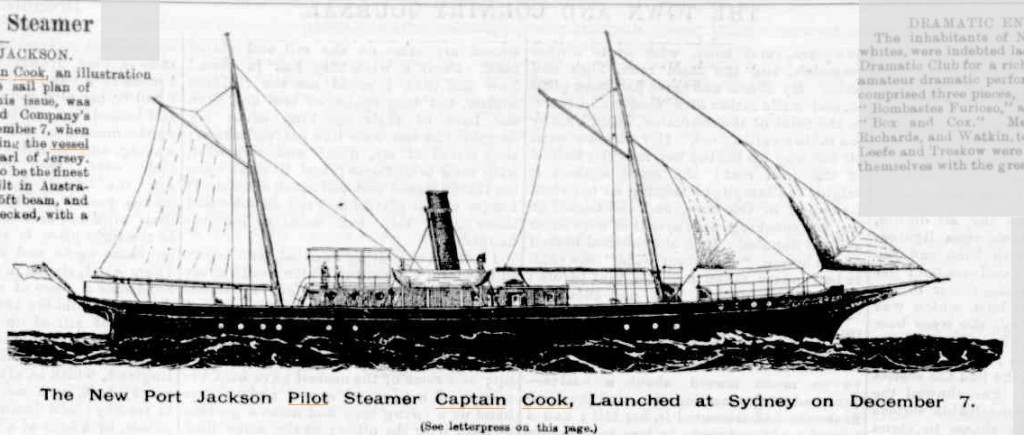
Captain Cook Pilot Vessel - the first one, from article above.
OF all the ships which have graced our harbour and have ended their career at the end of a towline, the most admired was the pilot steamer Captain Cook, familiarly know as "the watchdog of the Heads."
In February, 1877, the first vessel to bear the name of the famous navigator came on station at Watson's Bay. She was a wooden ship of 185 tons with a straight stem. She was replaced in 1893 by a second Captain Cook, a steel ship of 396 tons. Launched in December, 1892, she was commissioned in May, 1893, and made an average speed of 12knots on her trials. Captain Cook II was in the pilot service for more than 45 years and had many rescues to her credit, as well as valuable fire and salvage work.
Her faithful service as a pilot steamer ended in March,1939, when she vacated the berth at the buoy at Watson's Bay in favour of the present and third ship to bear the honoured name. Captain Cook's fine figurehead was transferred to her successor.
" Renamed Captain. Phillip, the old veteran rendered service as a training ship for the Australian Sea Cadet Corps, and during, the last war personnel of the Australian Army Water Transport Section were trained in her. In October, 1947, having at long, last outlived her usefulness, she was towed out to sea and sunk. TWO notable ships in the graveyard are the Namoi, 809 tons, built in 1883, and the Newcastle, of .1,251, tons, built in 1888. They were well known for their distinctive features of two funnels – the Newcastle originally had three-and their paddlewhccls. They voyaged between Sydney and Newcastle for many years. How fondly can we recall the regular 11 p.m. sailings from Sydney, and the awakening by the steward with tea upon arrival at Newcastle early next morning. The Namoi and the New-castle were sunk in January, 1932.
THE Barrabool and the Gabo were favourite passenger steamers of Howard Smith and Company. Both arrived in Australia in 1883. The Barrabool was in many collisions, and rammed and sank three steamers. It is said she steered badly. Old captains said they got out of her way when they saw her coming. She finished her days as a coal hulk in Sydney and went to her last plunge in September, 1950, 76 years after her launching. The Gabo was sunk in November, 1933.
All these are among the assemblage of once staunch ships, the once proud handiwork of shipwright and ship-builder, the once cherished commands of zealous masters, which now "sleep beneath the waves, hard by their native shore." HERALD FEATURES 100 Fathoms Deep, 18 Miles Off Sydney Heads, Is... The Graveyard Of Once Proud Ships. (1954, September 22). The Sydney Morning Herald (NSW : 1842 - 1954), p. 12. Retrieved from http://nla.gov.au/nla.news-article27515074
In 1875 Mort's Dock designed and built the first pilot steamer, Captain Cook, a vessel 123ft 6in long, of 287 tons. She did good service for some 16 years, and, in 1891, the firm secured the order for the second Captain Cook, 156ft long and of 396tons. This familiar vessel has been in continual service since. She was commissioned in 1893, and is still running. That she should be doing so speaks well for Australian shipbuilding and workman-ship. After 45 years' continuous service she will go out of commission this year, as Mort's Dock has again secured an order in competition to build a third Captain Cook. This craft is now under construction, and is expected to be completed this year. The length had been again increased, and is 170ft, with a tonnage of 450. SHIPBUILDING INDUSTRY IN AUSTRALIA. (1938, March 28).The Sydney Morning Herald (NSW : 1842 - 1954), p. 7 Supplement: Engineering Supplement. Retrieved from http://nla.gov.au/nla.news-article17452552
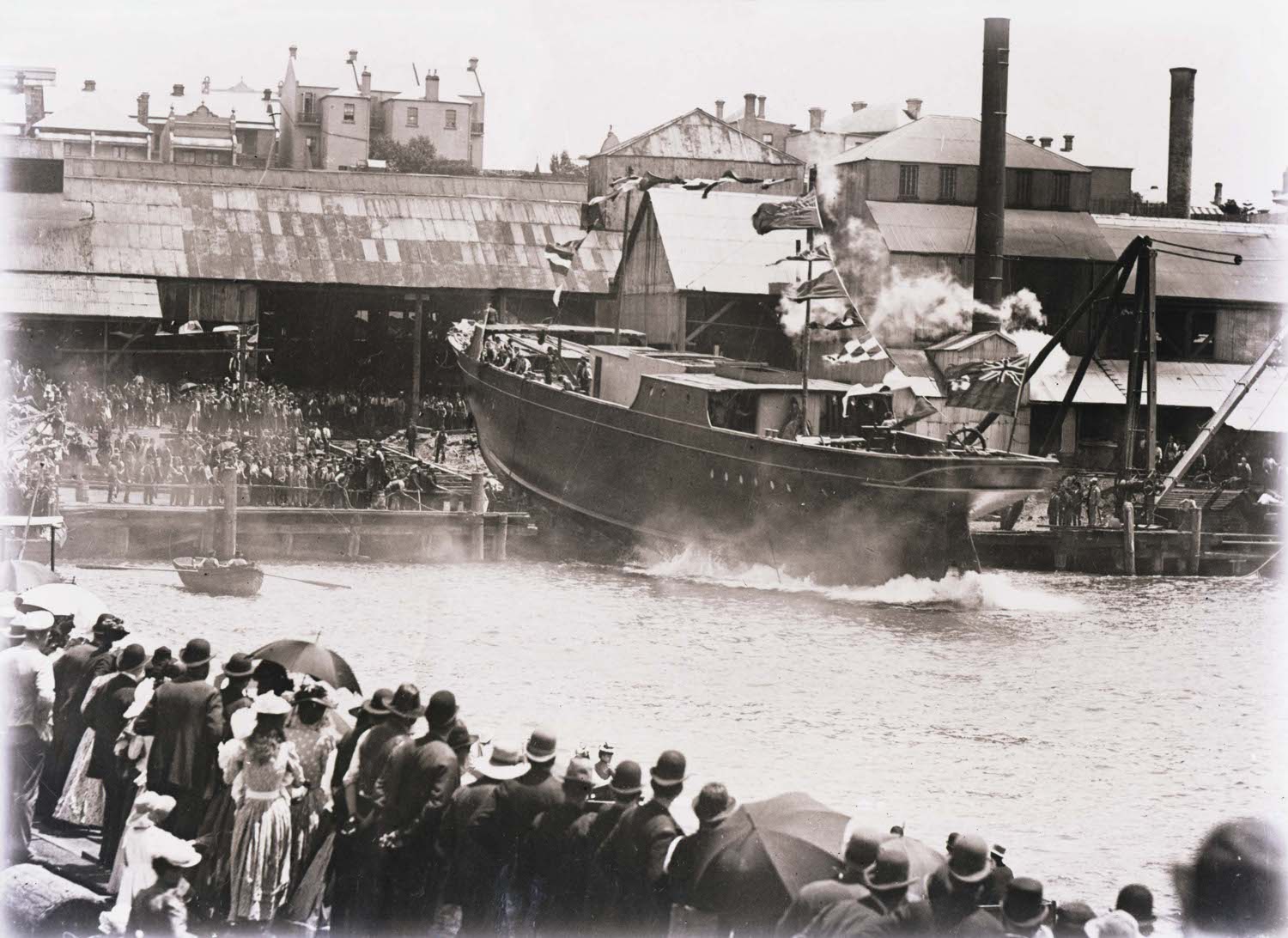
SYDNEY SEA SCOUTS GET NOTABLE SHIP
Captain Phillip, formerly the pilot steamer Captain Cook, which has been refitted as a harbour training ship for Sea Scouts and will be handed over at Balmoral Depot on August 31. Built in 1893,the vessel was paid off in 1939, but was re-commissioned during the war for the Docks Operating Company, A.I.F. SYDNEY SEA SCOUTS GET NOTABLE SHIP. (1946, August 13). The Sydney Morning Herald (NSW : 1842 - 1954), p. 3. Retrieved from http://nla.gov.au/nla.news-article17988994
OUR PILOT SERVICE. OFF PORT JACKSON.
(See double page illustration.)
'A line for the pilot boat ' is the order which creates more excitement on ship-board than any other event of a sea voyage. Even the sailor in whom long use has blunted the sting of parting and dimmed the joy of meeting, feels his heart beat a trille faster when he hears this command. To the outward bound passenger the departure of the pilot means the severance of the last link between him and home. To the pilot he hands the letter which contains his final words off are well to the friends he has left behind, and the pilot's departure will probably linger in his memory when most other incidents of the voyage are forgotten. If the traveller is homeward bound, the sight of the pilot boat reminds him that he is separated from his friends by only a few hours ; and if the shores of a strange country are in view, the pilot is an object of keen interest, for is he not the first acquaintance among the new friends yet to be made ? Few people, however, trouble themselves to enquire as to how it is the pilot seems to turn up just when he is wanted, or as to what becomes of him when the ship is safely moored in harbour. It is only when the novelty of landing has worn off, and the incidents of the voyage are discussed as things of the past, that the traveller begins to regard the coming and going of pilots with some interest. The illustrations which accompany this article are from sketches made by our special artist, and they will give the reader a good insight into the working of the Port Jackson Pilot Service.
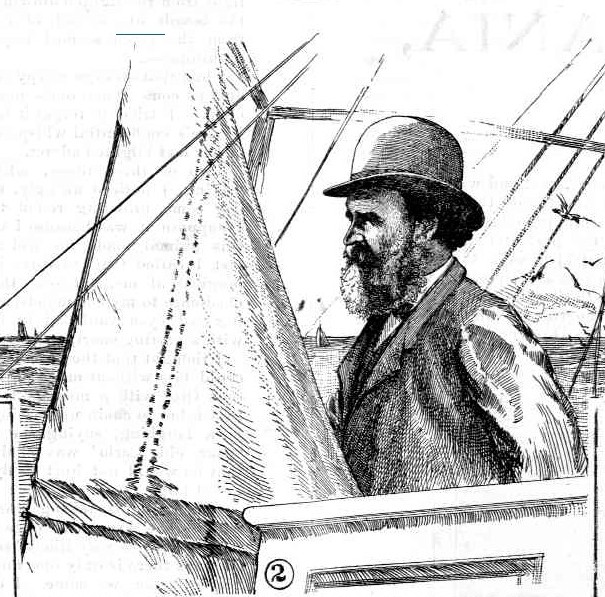 The service is one of the most efficient, as well as interesting, of our marine institutions, and the Marine Board, under whose jurisdiction it is, have good reason to be proud of it. Our illustrations include a picture of the pilot steamer ‘Captain Cook,' lying moored to a buoy in Watson's Bay. The steamer there awaits, at all hours, the signal that a pilot is wanted. When a vessel requiring a pilot(and this includes all ships whose captains do not possess, on account of their knowledge of the harbour, an exemption certificate from the Marine Board), arrives near enough to the South Head Signal Station for the signalman on duty there to make her out, the fact is made known to the' Captain Cook.' Day and night a man is on the look-out on the bridge of the steamer for the flag, or the light, which is the signal that the pilot is wanted. The moment that the signal is made, the alert look-out man passes the word to the crew,and the captain gives the order to ' proceed.' The moorings are so arranged that they can be cast off as quickly almost as the order is given, and in an incredibly short time the steamer is on her way outside. Captain J. Creer (picture), whose portrait on the bridge of his trim little vessel is among our illustrations, has charge of the service, and out of the eighteen years he has been employed in it, for twelve of them he has occupied his present responsible position. Five pilots are stationed at Port Jackson, three of them remain on shore at Watson's Bay, and two are always standing by onboard the 'Captain Cook.' An incoming ship is met about a mile outside the Heads, and when the pilot steamer gets within a safe distance of her a boat is lowered, and a pilot conveyed from the ‘Captain Cook ' to the new arrival. In bad weather this is by no means an easy task, and skill and courage are required to perform the manouvre successfully. Sometimes the sea is running so high that it is too dangerous to admit of lowering a boat, and in that case the pilot steamer leads the way to a safe anchorage by steaming ahead of the ship. Our illustrations include two incidents in the every-day life of the pilot crew-lowering one of the ‘Captain Cook's ' boats, and getting alongside of an outward-bound mail steamer to take off the pilot. This is another duty assigned to the ' Captain Cook's ' crew, and it is by no means so easy to get alongside of a big steamer, when the sea is at all rough, as the lands-man may suppose.
The service is one of the most efficient, as well as interesting, of our marine institutions, and the Marine Board, under whose jurisdiction it is, have good reason to be proud of it. Our illustrations include a picture of the pilot steamer ‘Captain Cook,' lying moored to a buoy in Watson's Bay. The steamer there awaits, at all hours, the signal that a pilot is wanted. When a vessel requiring a pilot(and this includes all ships whose captains do not possess, on account of their knowledge of the harbour, an exemption certificate from the Marine Board), arrives near enough to the South Head Signal Station for the signalman on duty there to make her out, the fact is made known to the' Captain Cook.' Day and night a man is on the look-out on the bridge of the steamer for the flag, or the light, which is the signal that the pilot is wanted. The moment that the signal is made, the alert look-out man passes the word to the crew,and the captain gives the order to ' proceed.' The moorings are so arranged that they can be cast off as quickly almost as the order is given, and in an incredibly short time the steamer is on her way outside. Captain J. Creer (picture), whose portrait on the bridge of his trim little vessel is among our illustrations, has charge of the service, and out of the eighteen years he has been employed in it, for twelve of them he has occupied his present responsible position. Five pilots are stationed at Port Jackson, three of them remain on shore at Watson's Bay, and two are always standing by onboard the 'Captain Cook.' An incoming ship is met about a mile outside the Heads, and when the pilot steamer gets within a safe distance of her a boat is lowered, and a pilot conveyed from the ‘Captain Cook ' to the new arrival. In bad weather this is by no means an easy task, and skill and courage are required to perform the manouvre successfully. Sometimes the sea is running so high that it is too dangerous to admit of lowering a boat, and in that case the pilot steamer leads the way to a safe anchorage by steaming ahead of the ship. Our illustrations include two incidents in the every-day life of the pilot crew-lowering one of the ‘Captain Cook's ' boats, and getting alongside of an outward-bound mail steamer to take off the pilot. This is another duty assigned to the ' Captain Cook's ' crew, and it is by no means so easy to get alongside of a big steamer, when the sea is at all rough, as the lands-man may suppose.
The rapidity and precision with which every man on board the ‘Captain Cook ' performs his share of the duty, was shown on a recent occasion, when the writer had the privilege of being on board of her. In less than two minutes from the time of the signal being made at South Head, the steamer was under weigh, and heading outwards. Captain Creer is justly proud of the fact that the look-out is so well kept on board the steamer, that when he is on shore and wants the boat lowered for him, a wave of his handkerchief from any part of Watson's Bay, visible from the bridge of the 'Captain Cook,' has never yet failed to elicit a response. On the particular day referred to above, there was a * lumpy 'sea on outside the Heads, making it anything but a favourable time for boat lowering. Suddenly, and without warning of any kind, Captain Creer seized a life-buoy and threw it overboard, and at the same time ordered a boat to be lowered to pick it up. The steamer was stopped, the boat lowered, and the buoy, which had drifted a considerable distance from the ship, was picked up, the boat hoisted again, and the steamer going ahead before the visitor had recovered from his surprise. The whole operation was too sudden, and had been performed too quickly for anyone to have thought of timing it ; but the entire proceedings from the time the buoy was thrown overboard, until the boat's crew had recovered breath from their exertions, and had, apparently, almost forgotten the incident, certainly did not occupy move than four or five minutes. This high state of efficiency is brought about by the evident interest that every member of the crew takes in his work. Most of the men have spent many years in the service, the newest comer among them having been something like four years in the ‘Captain Cook.' The Chief Officer, Mr. Place, and the Second Officer, Mr. Fotheringham, ably support Captain Creer in keeping things up to the mark. Portraits of these two officers are included in our illustrations. Mr. Broderick, the Chief Engineer, has been in charge of the engines since the pilot steamer was launched from Mort's Dock in January, 1877, and he and his Second Engineer, Mr. H. B. Irving, have a just pride in the excellent condition of their engines, after the long service they have seen ;a service made doubly trying in this steamer, where it is necessary to have steam up night and day. There is, however, one drawback-the ' Captain Cook ' is too slow. In bad weather, when it is necessary for the pilot steamer to lead the way into port, great difficulty is sometimes experienced in keeping ahead of the vessel to be piloted, for a modern steamer going at her slowest speed will, at times, go faster than the ' Captain Cook.' This is an evil that steps have already been taken to remedy, and a faster steamer has been promised. Another slight improvement the Marine Board might very easily effect, is to put the crew of the pilot steamer in uniform, after the fashion of the employees of the Harbours and Rivers Department. The vessel is such a picture of cleanliness and good order from stem to stern, that the whole effect is slightly marred from the want of this trifling outlay.
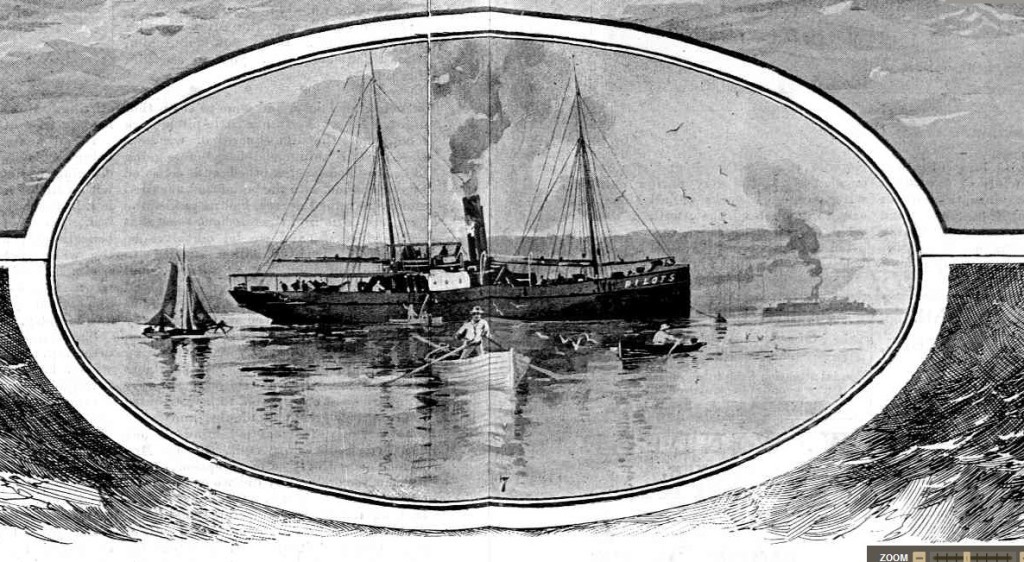

(For letterpress see page 18.)
1. RETURNING TO ' CAPTAIN COOK ' WITH PILOT FROM OUTWARD BOUND STEAMER. 2.CAPTAIN J. CREER, COMMANDER OF THEPILOT SERVICE. 3. MR. PLACE, CHIEF OFFICER OF THE < CAPTAIN COOK.' 4. MR. FOTHERINGHAM, SECOND OFFICER OF THECAPTAIN COOK.' 5. LOWERING ONE OF THE «CAPTAIN COOK'S ' BOATS TO GO FOR PILOT. 6. GETTING ALONGSIDE AN OUTWARD BOUND MAIL STEAMER TO TAKE OFF THE PILOT. 7. tSE ' CAPTAIN COOK ' AT HER MOORINGS IN WATSON'S BAY, WAITING FOR THE SIGNAL TO FROCKED.'
Our Pilot Service.
A little steam launch is also kept at Watson's Bay, and this acts as a kind of tender to the ' Captain Cook.' When a vessel requires to be piloted out of Sydney Harbour, a telegram is sent to South Head, and one of the pilots, whose turn it is to remain on shore at his residence at Watson's Bay, embarks on the launch, and is conveyed by it to the ship, where he remains until she is well clear of the Heads, when he is taken off, as has already been shown, by one of the boats from the' Captain Cook.' Attending to the pilot signals is not the only work performed by the pilot steamer. The laying of buoys, and such-like operations, is another service which devolves upon her. But above all else in the list of her services stands the splendid record of lives and property saved by Captain Creer and his crew. It is the duty of the pilot steamer to render all the aid in her power to vessels in distress, and over and over again has that duty been performed by the people on board of her, in the worst weather, and in the face of terrible difficulties. The ship is supplied with the rocket apparatus, arid other life-saving appliances, which Captain Creer and his officers willingly explained the use of to the writer ; but brave men are modest, and they could not be induced to talk of the good work done.
The foregoing sketch of the pilot service clearly shows that, besides being in a high state of efficiency, the men composing it have, every one of them, ' The heart of a true British sailor.' Our Pilot Service. (1891, June 6). Illustrated Sydney News(NSW : 1853 - 1872), p. 12. Retrieved from http://nla.gov.au/nla.news-article63616697
The Australian Naval Station. ADMIRAL SCOTT TAKES COMMAND.
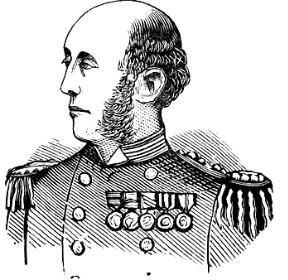 By the arrival of the E.M.S. Carthage from London this morning, Rear-Admiral Lord Charles Scott, C.B., the new commanding officer of the Australian Naval Station, was a passenger. The Carthage entered the Heads shortly before noon, and steamed up to an anchorage in Neutral Bay. H.M.S. Orlando, from Melbourne, which had been off the Heads from an early hour this morning, came to the Orlando buoy in Farm Cove shortly after 11. The Orlando is now under command of Captain Barlow, he having succeeded Captain Tyute Harnmill, who leaves Melbourne for England by E.M.S. Ormuz this afternoon. Flag Lieutenant E. P. Fitzgerald, who succeeds Flag Lieutenant Erskine, and the admiral's secretary, Mr. W. Le G. Pullen, who succeeds Mr. C. J. Pawsey, have also joined the Orlando. On the arrival of the Carthage at her anchorage The Admiral, Lady Scott, and parity were conveyed to Admiralty House.
By the arrival of the E.M.S. Carthage from London this morning, Rear-Admiral Lord Charles Scott, C.B., the new commanding officer of the Australian Naval Station, was a passenger. The Carthage entered the Heads shortly before noon, and steamed up to an anchorage in Neutral Bay. H.M.S. Orlando, from Melbourne, which had been off the Heads from an early hour this morning, came to the Orlando buoy in Farm Cove shortly after 11. The Orlando is now under command of Captain Barlow, he having succeeded Captain Tyute Harnmill, who leaves Melbourne for England by E.M.S. Ormuz this afternoon. Flag Lieutenant E. P. Fitzgerald, who succeeds Flag Lieutenant Erskine, and the admiral's secretary, Mr. W. Le G. Pullen, who succeeds Mr. C. J. Pawsey, have also joined the Orlando. On the arrival of the Carthage at her anchorage The Admiral, Lady Scott, and parity were conveyed to Admiralty House.
During the afternoon the Admiral will proceed to the flagship, when his commission will be read at a full dress parade of the ship's company, his flag will be hoisted, the customary salutes fired, and he will then be in official command of the station. With respect to the other vessels of the fleet, the Royalist is in Farm Cove; awaiting her relief crew from England, the Egeria is hourly expected to arrive from Tonga for a refit and to embark her relief crew, expected on December 10 by the s.s. Port Victor. The Swinger is expected to-day from Noumea ; and the Raven is also on her way to Sydney from New Guinea. The Rapid has gone to Noumea and New- Hebrides ; the Dart is surveying on the Queensland coast, the Rambler, from Western Australia, is on the way to Hobart, to give her crew a spell in cool weather; and H.M.S. Opal and H.M.S. Lizard are believed to have gone to Dunedin, N.Z., to represent the Royal Navy at the opening of the Exhibition. H.I.G.M.S. Alexandrine saluted the Admiral on arrival. The Australian Naval Station. (1889, November 22). Evening News (Sydney, NSW : 1869 - 1931), p. 4. Retrieved from http://nla.gov.au/nla.news-article117020754
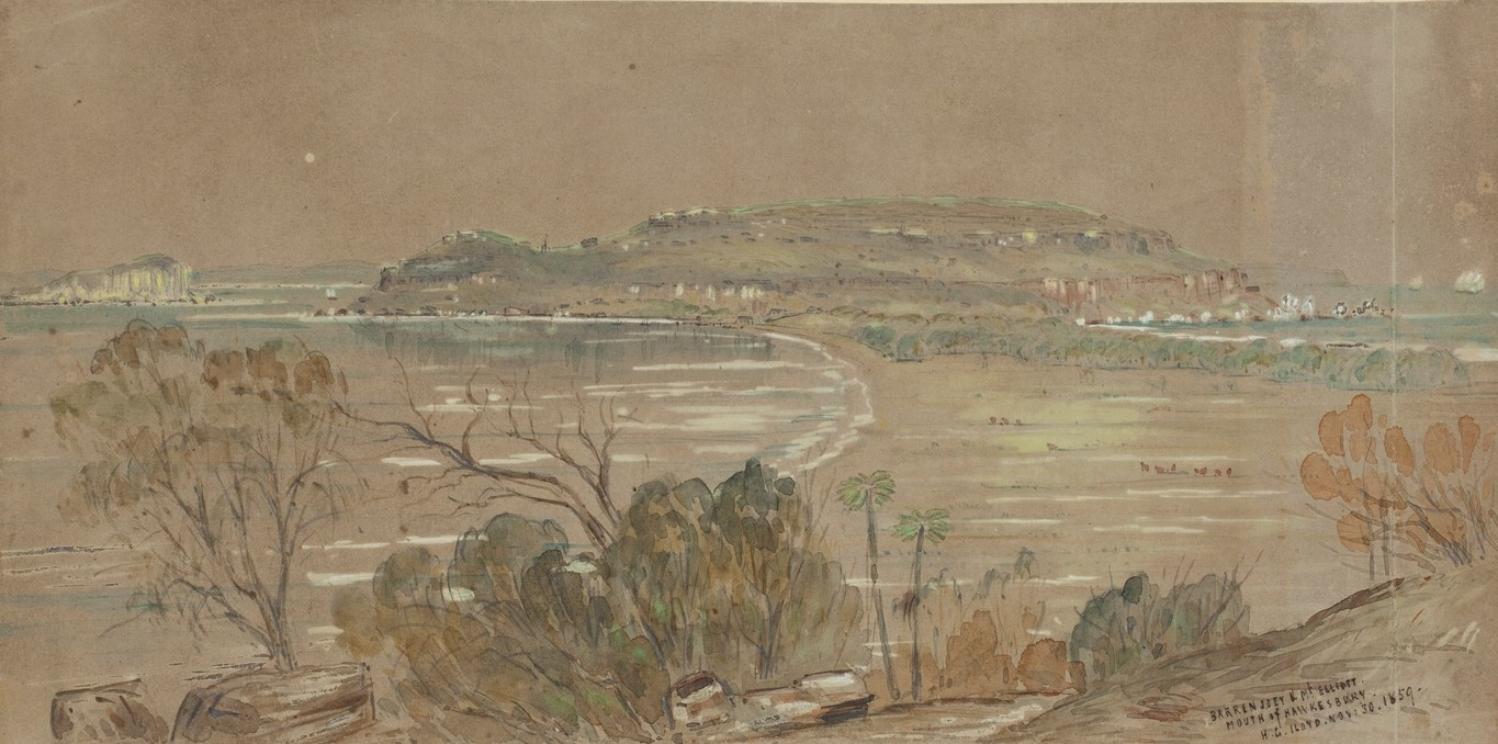
New South Wales First Colonial Naval Exercises and Naval Brigade Threads collected by A J Guesdon, 2013.